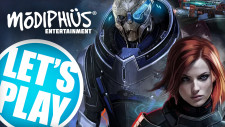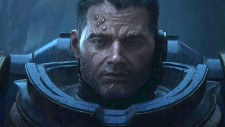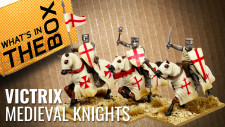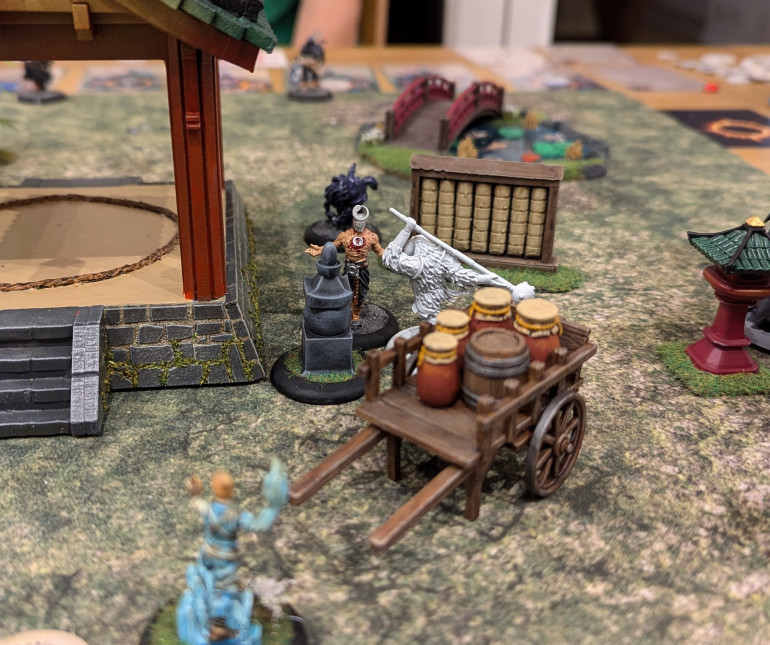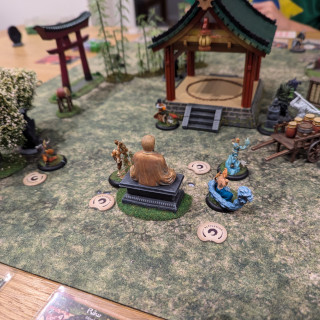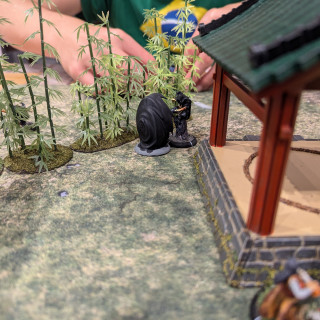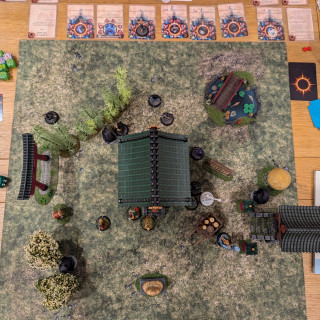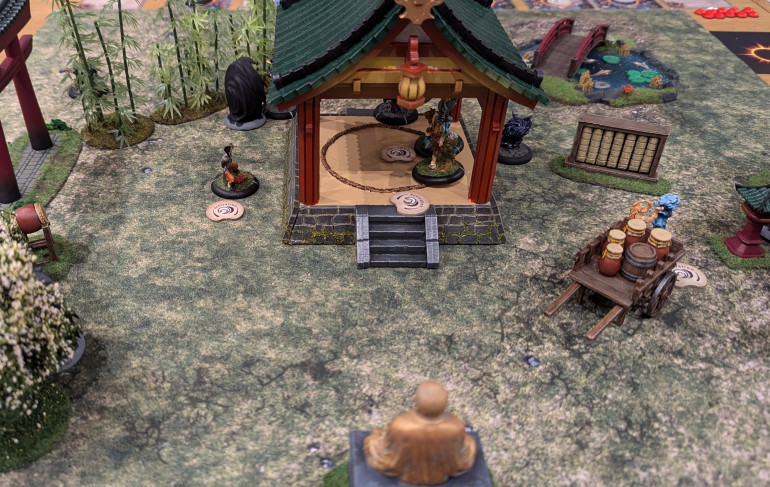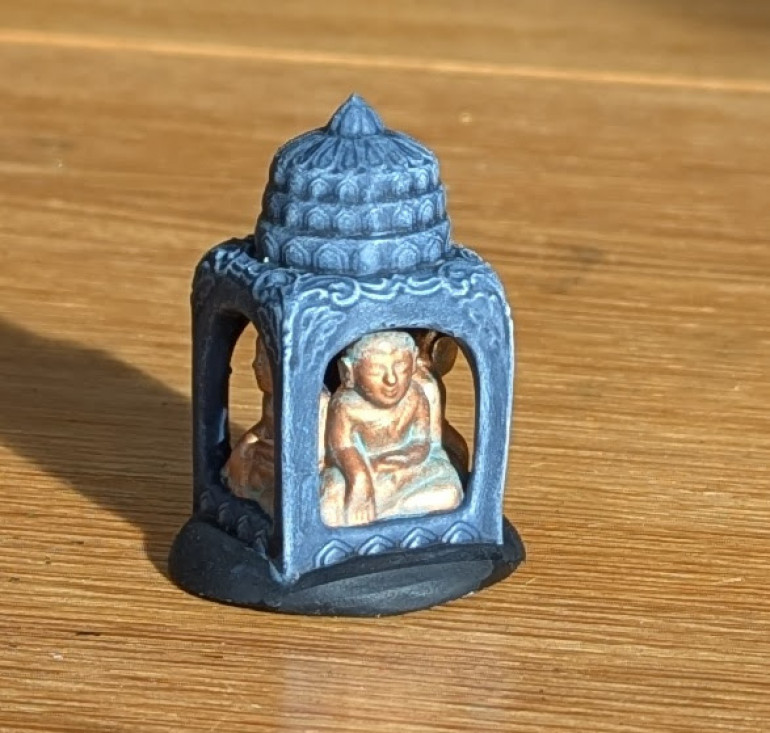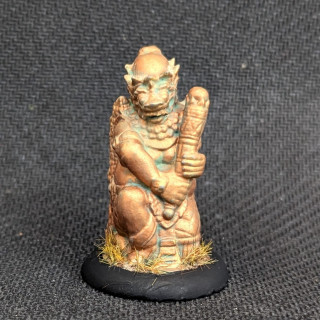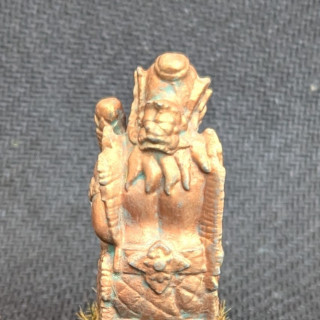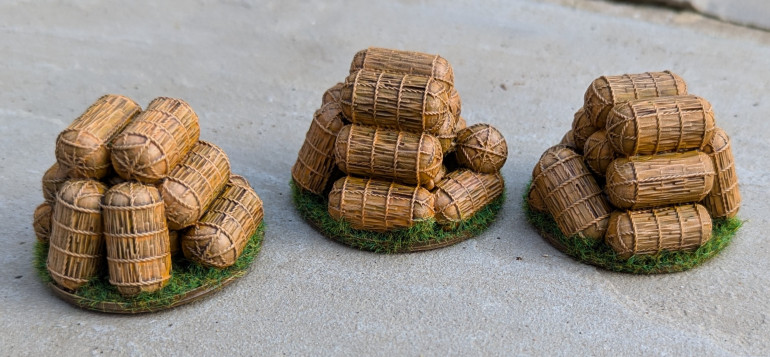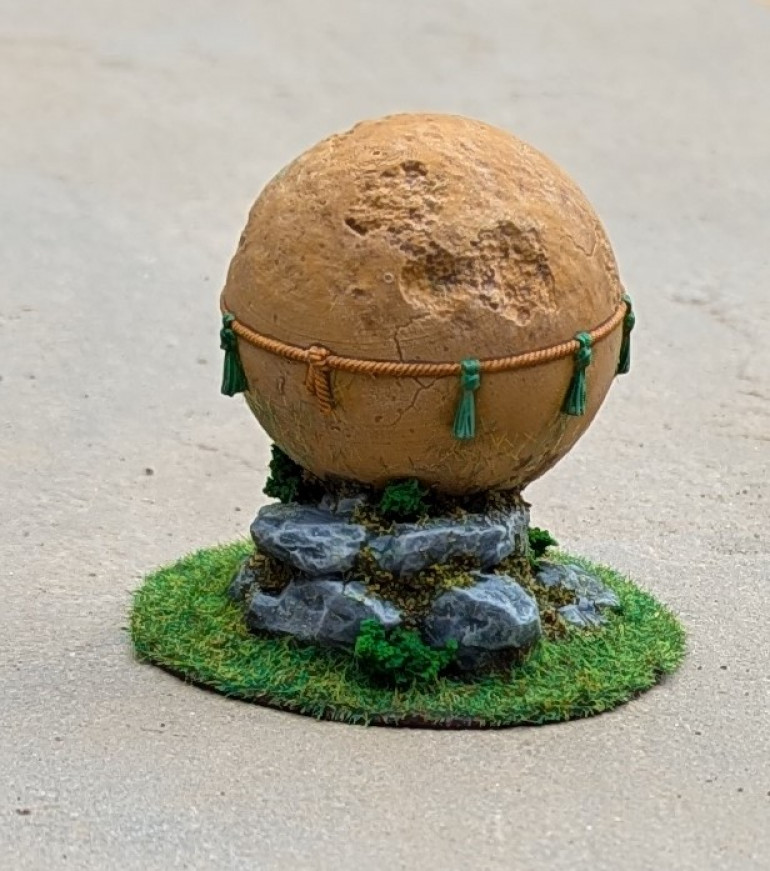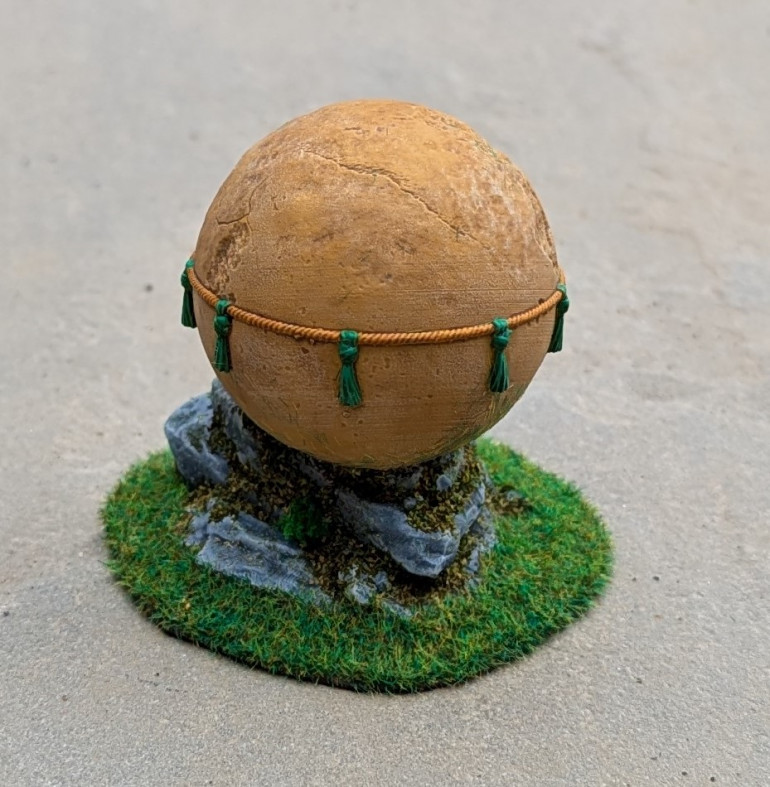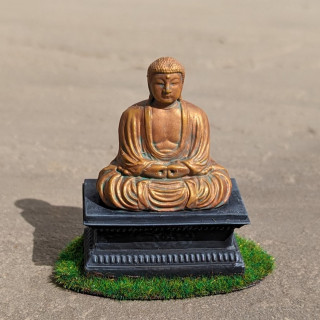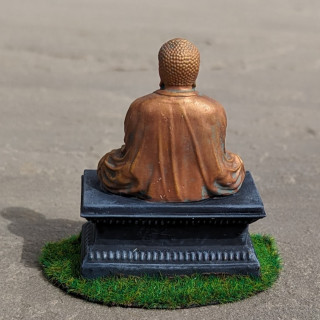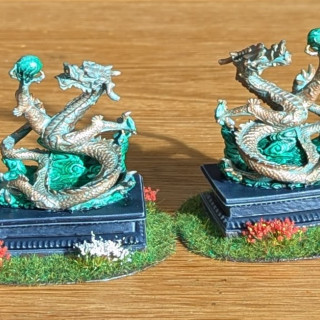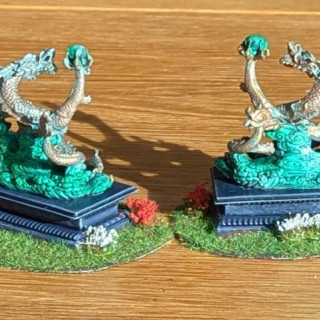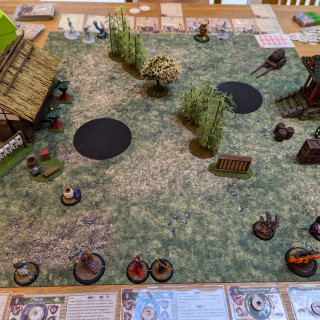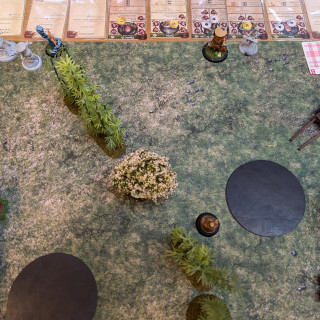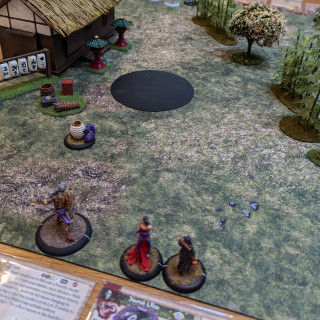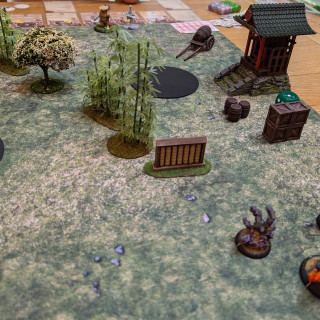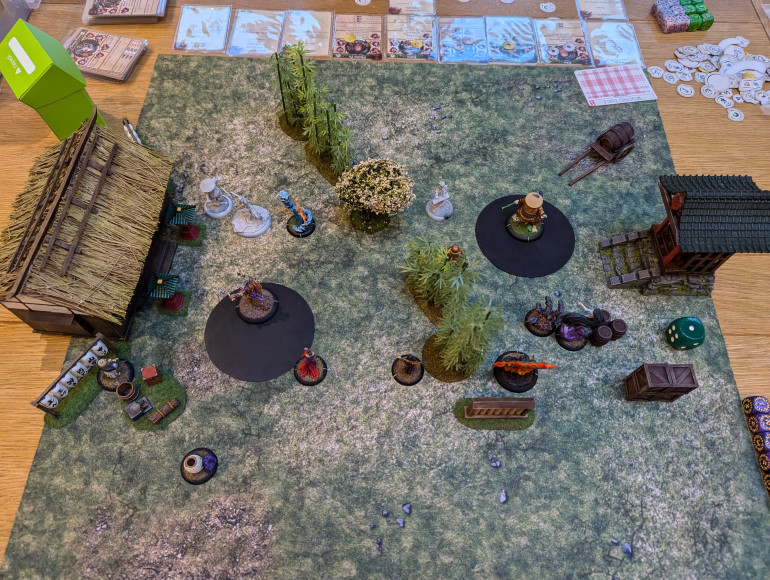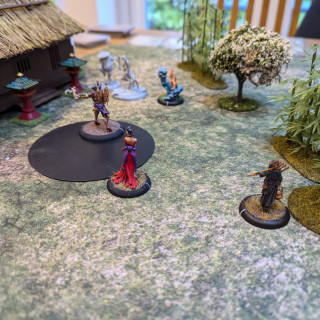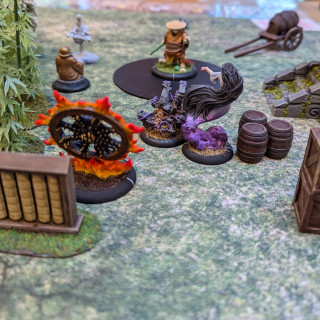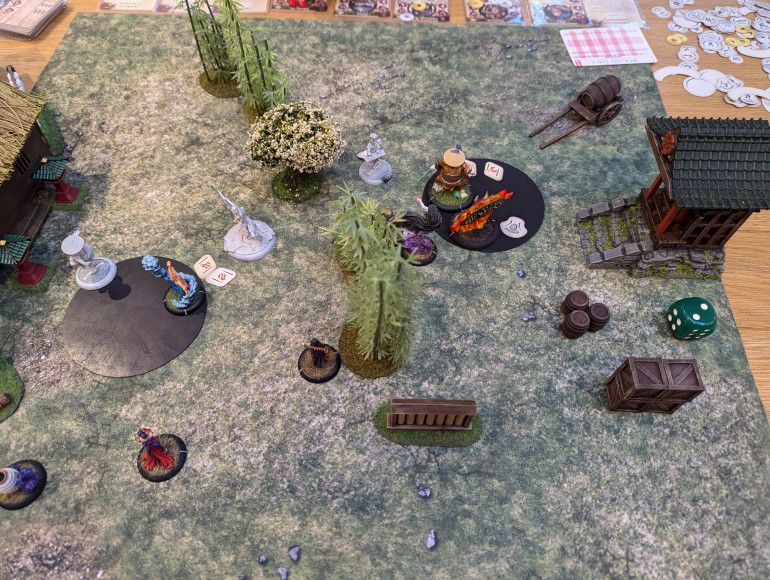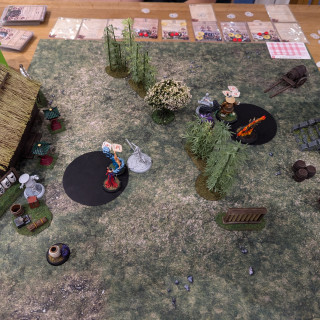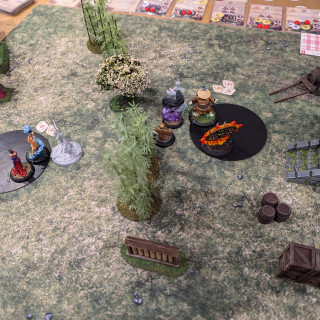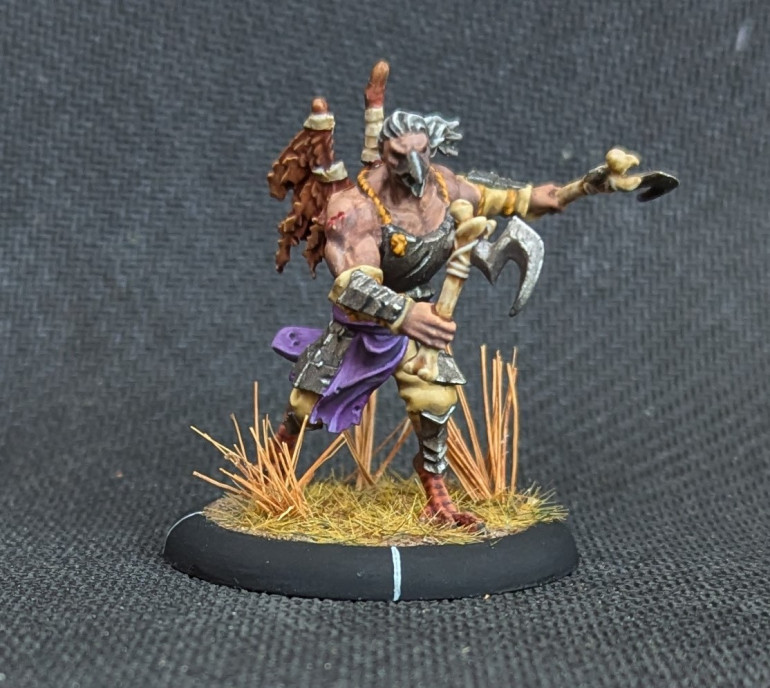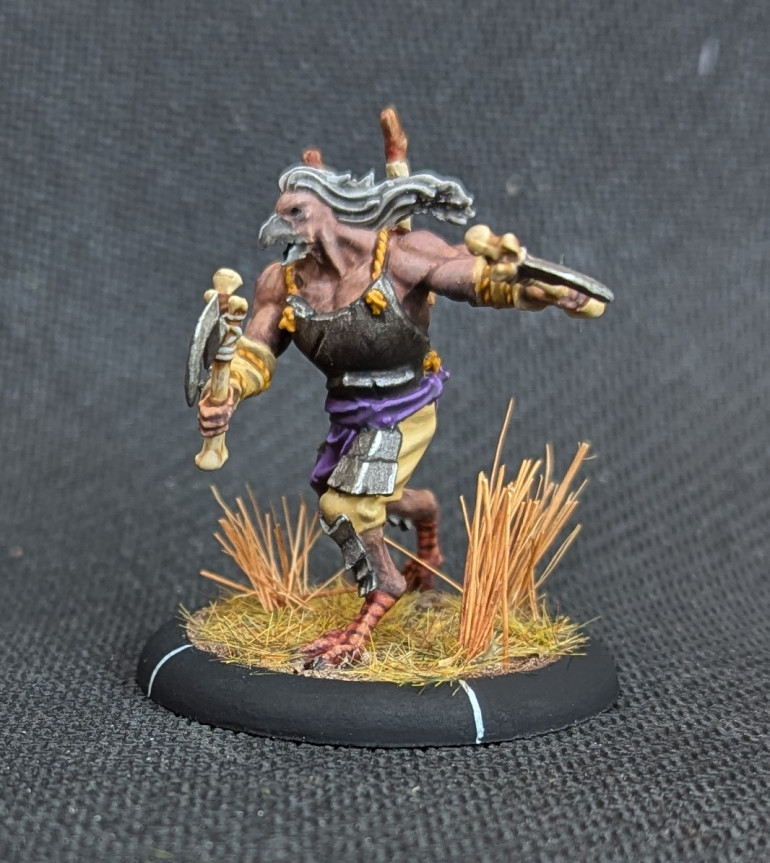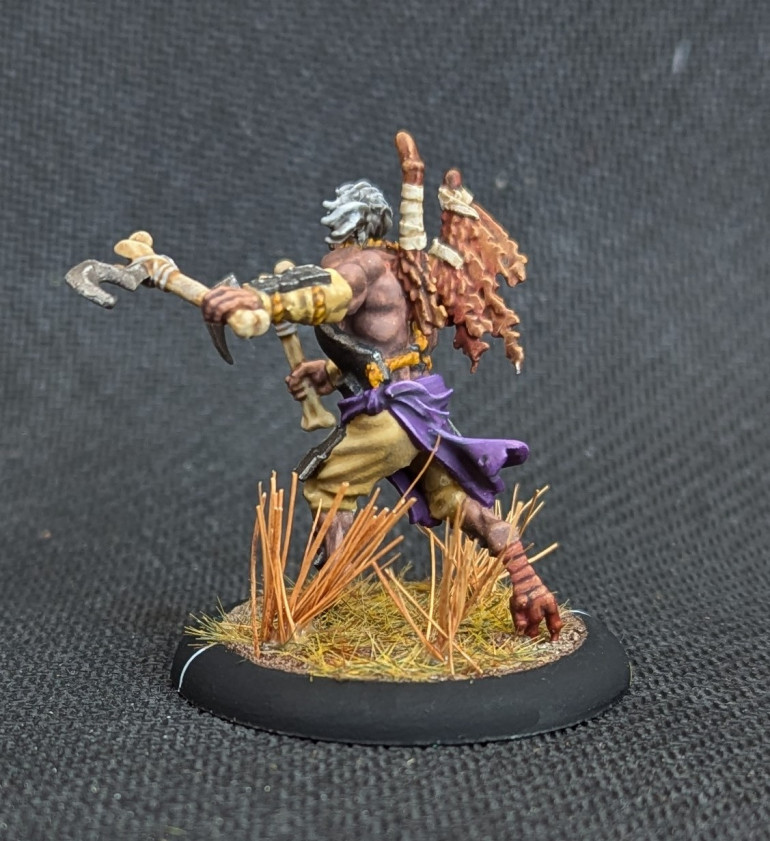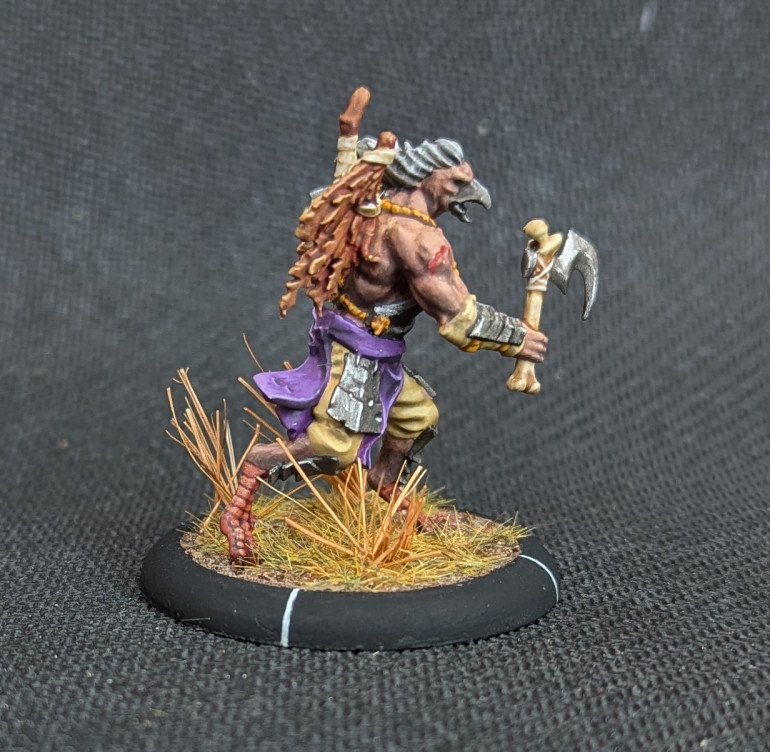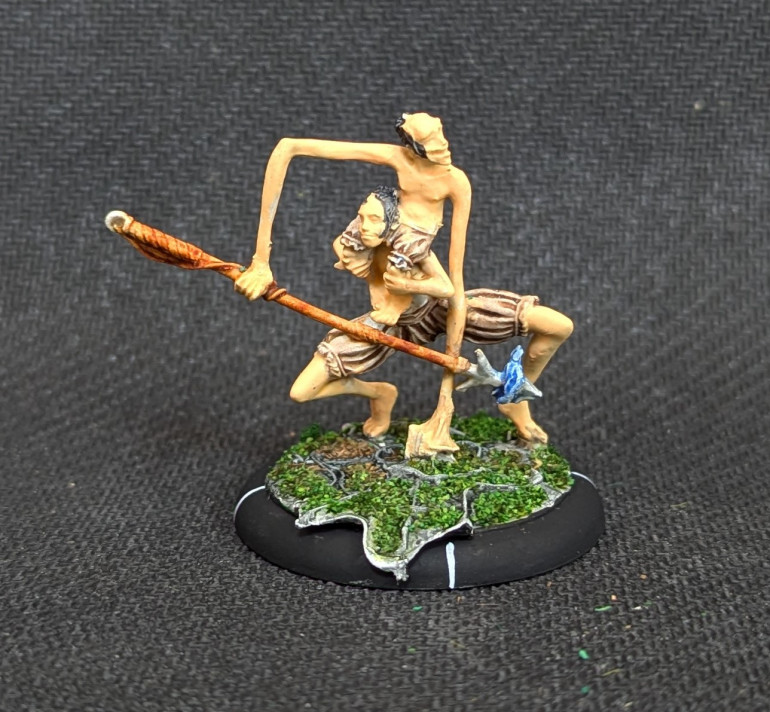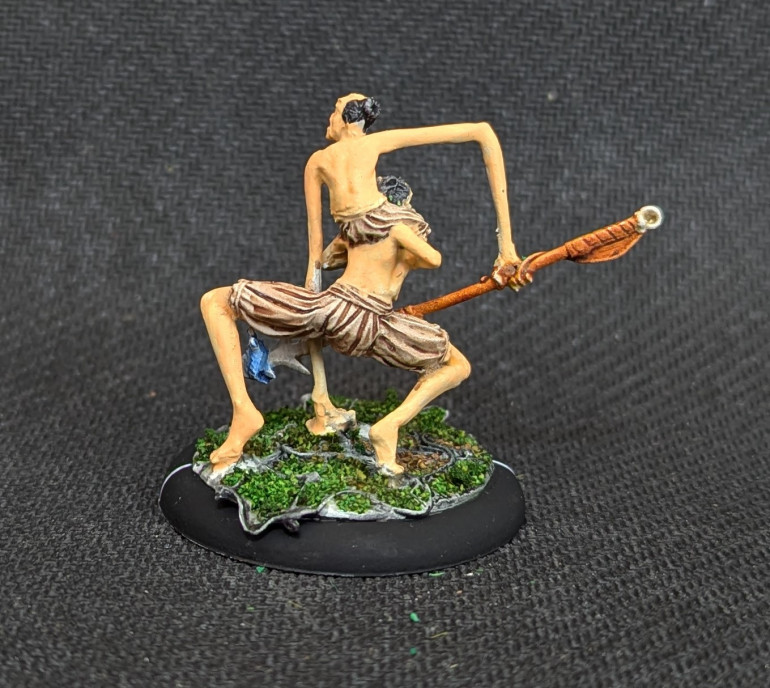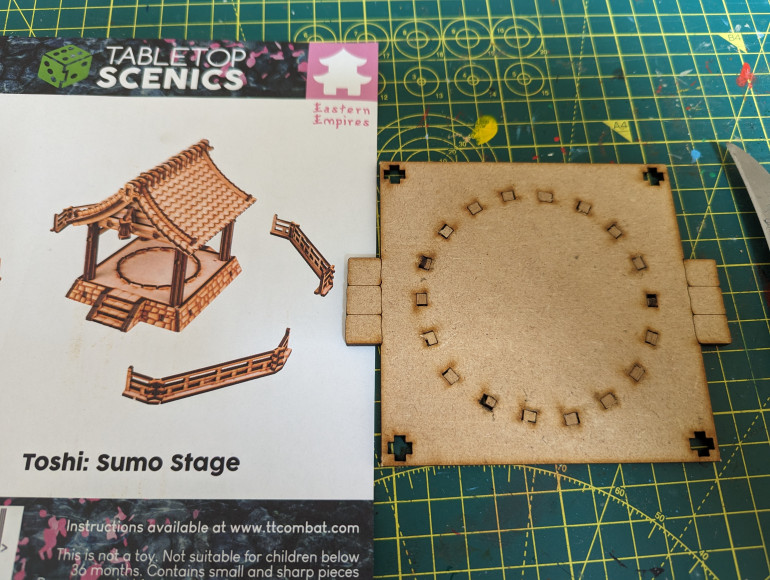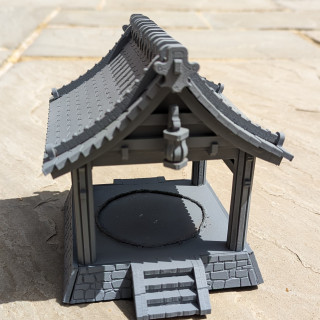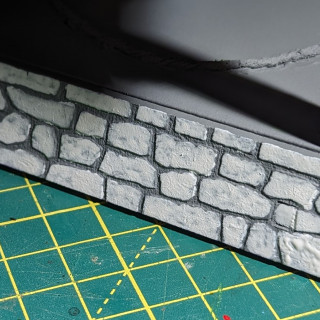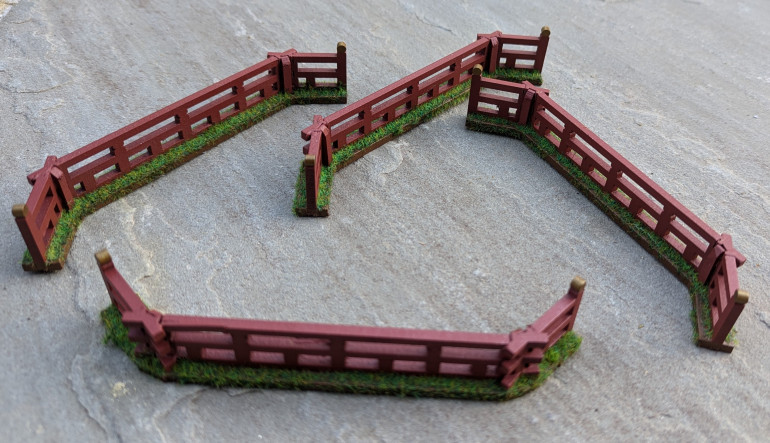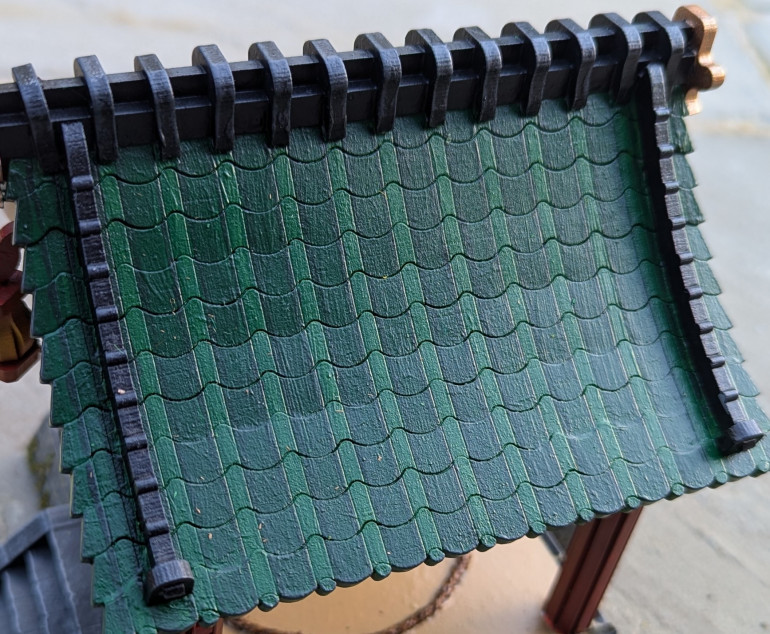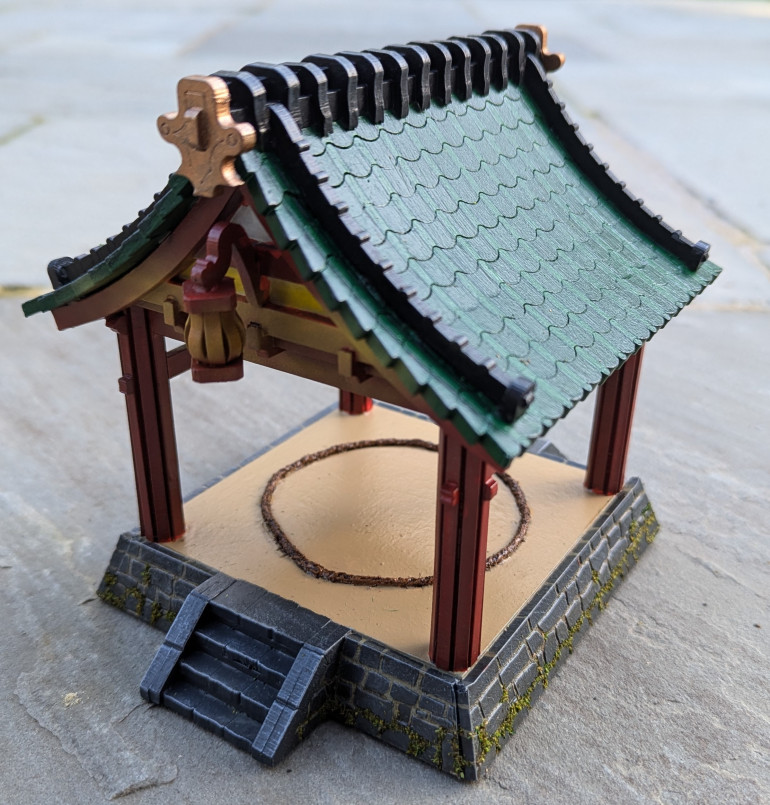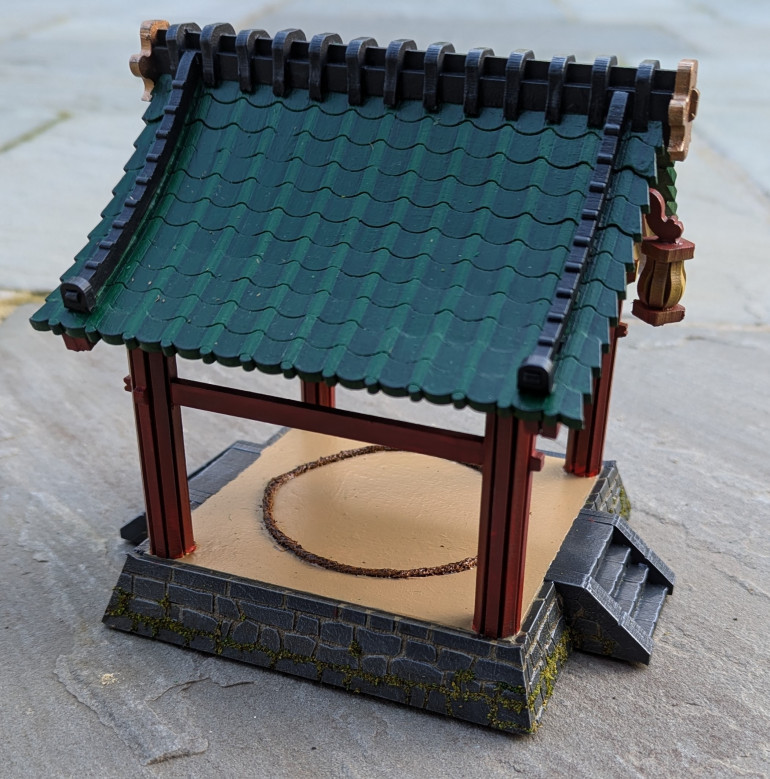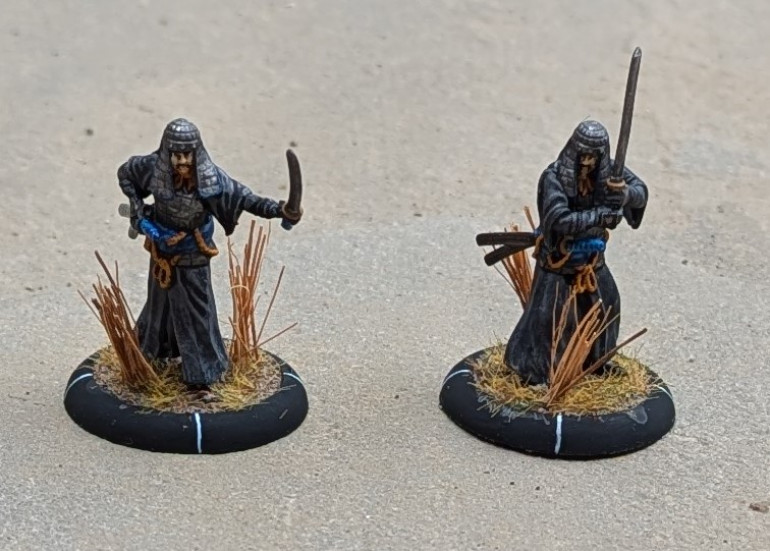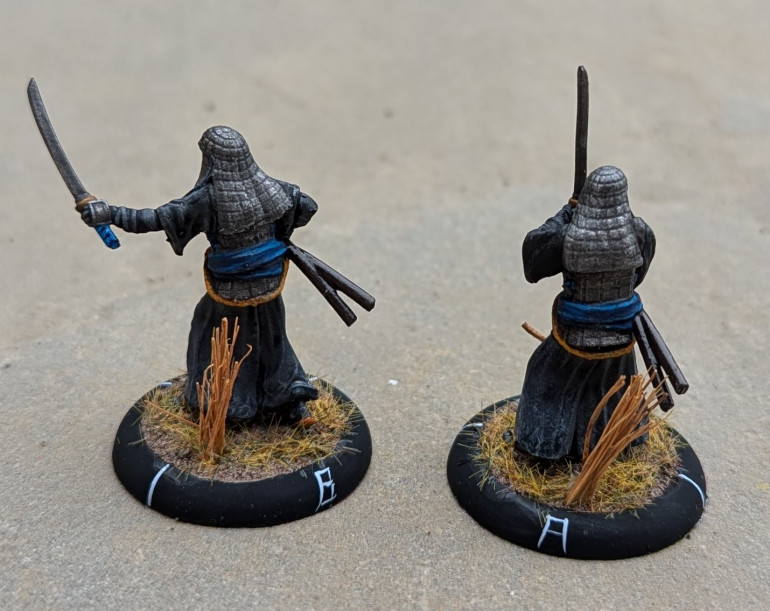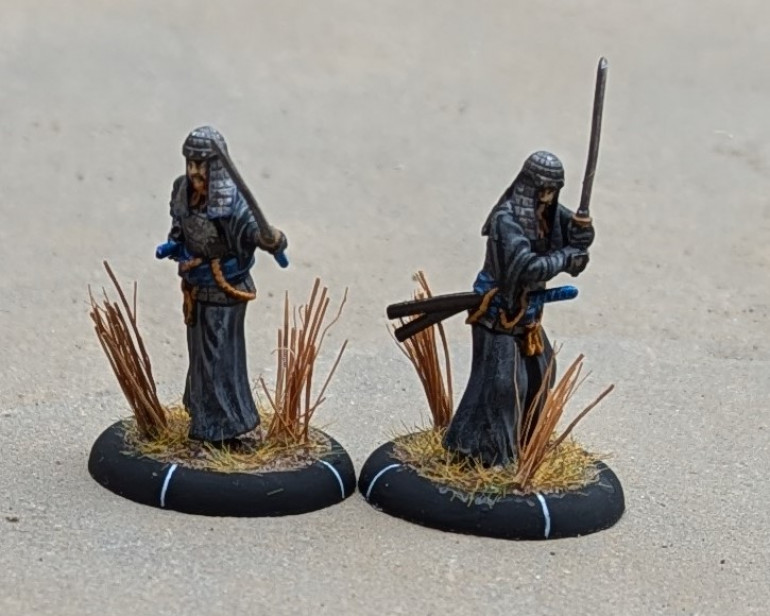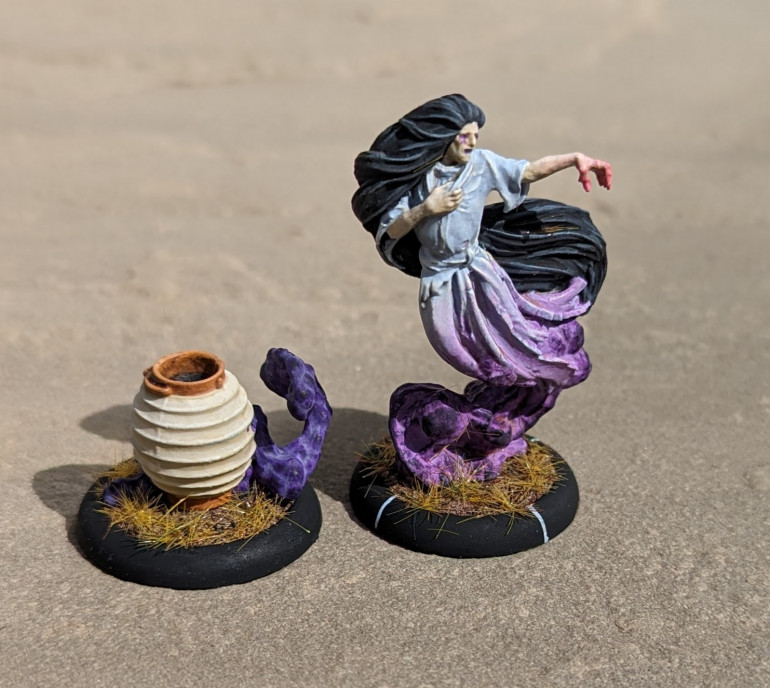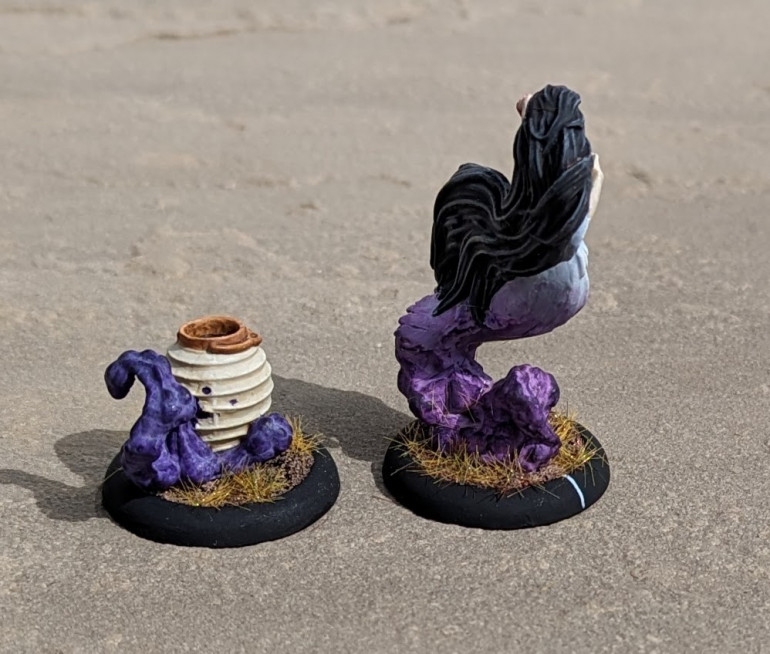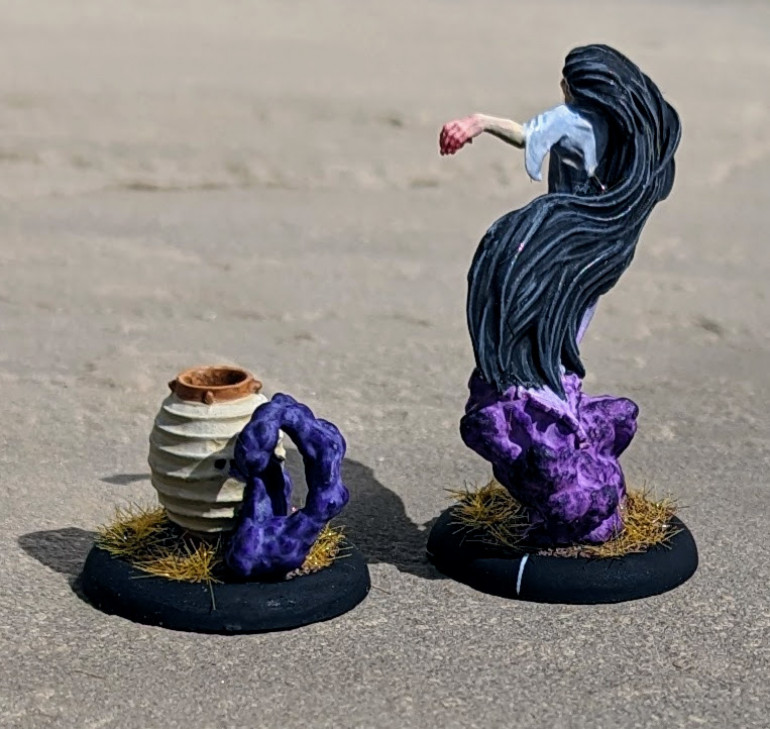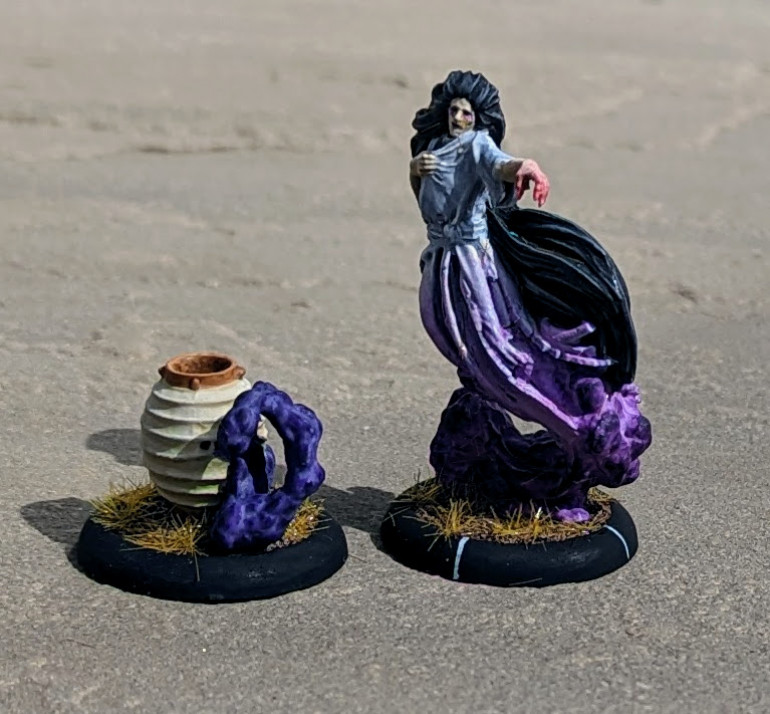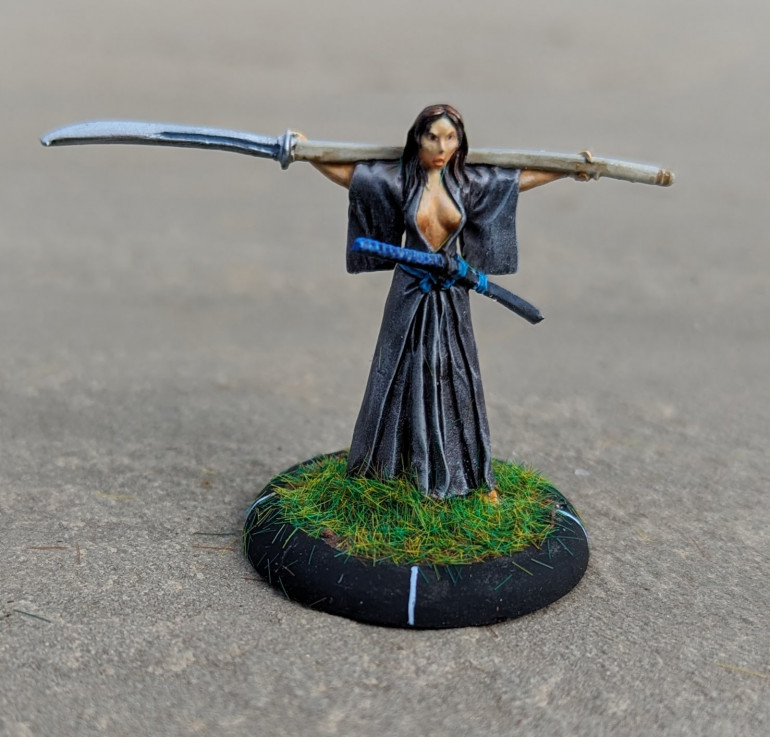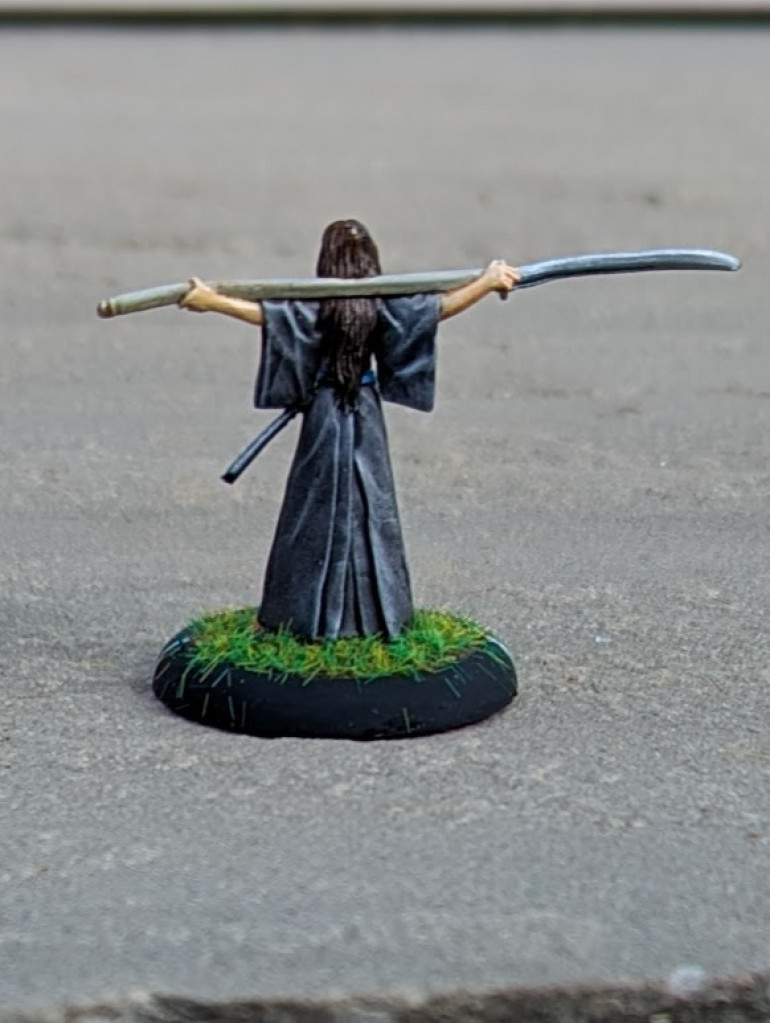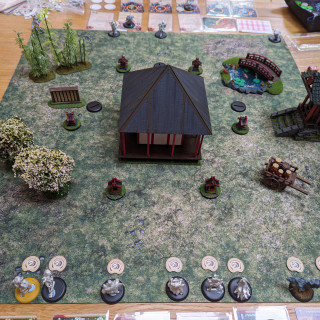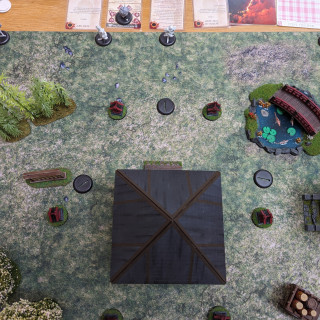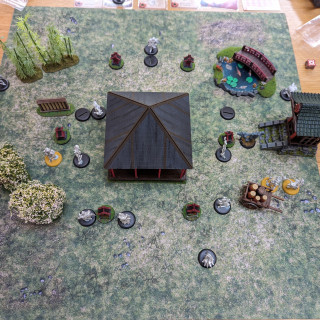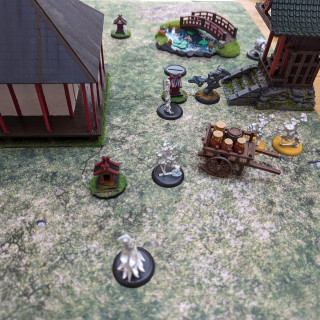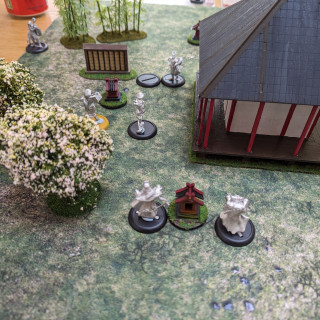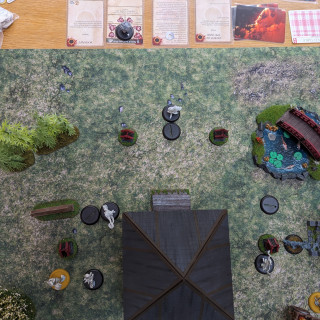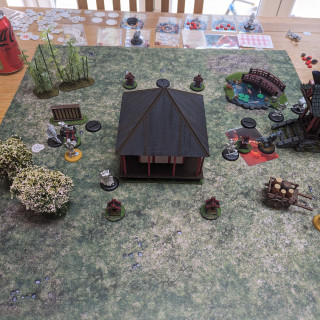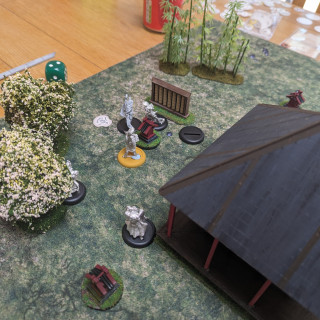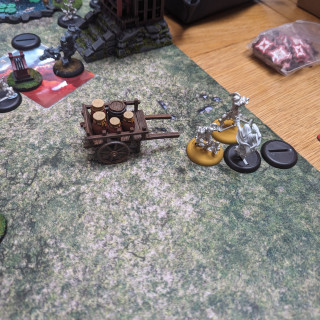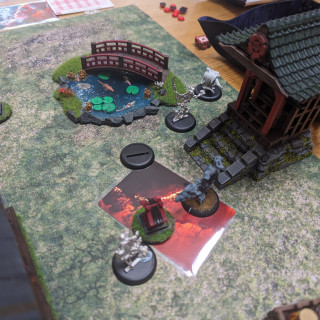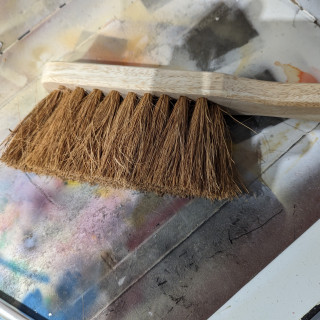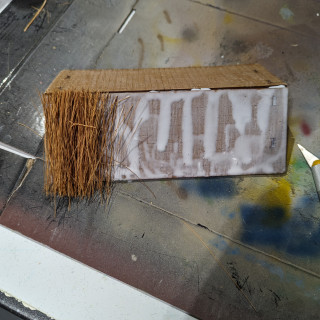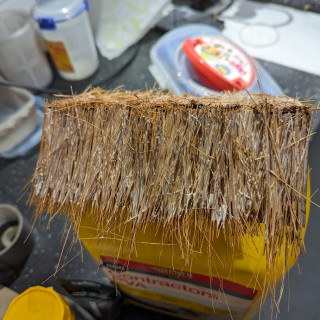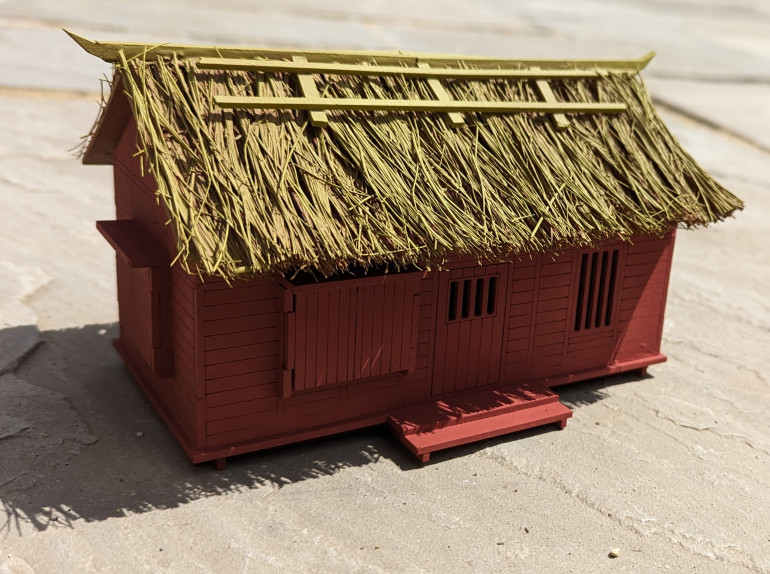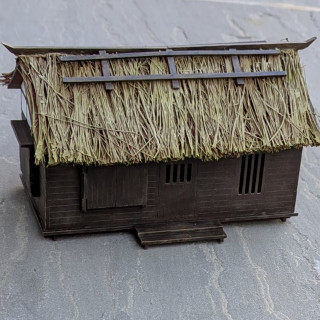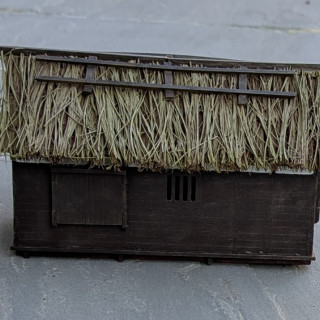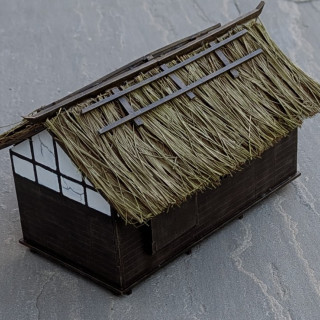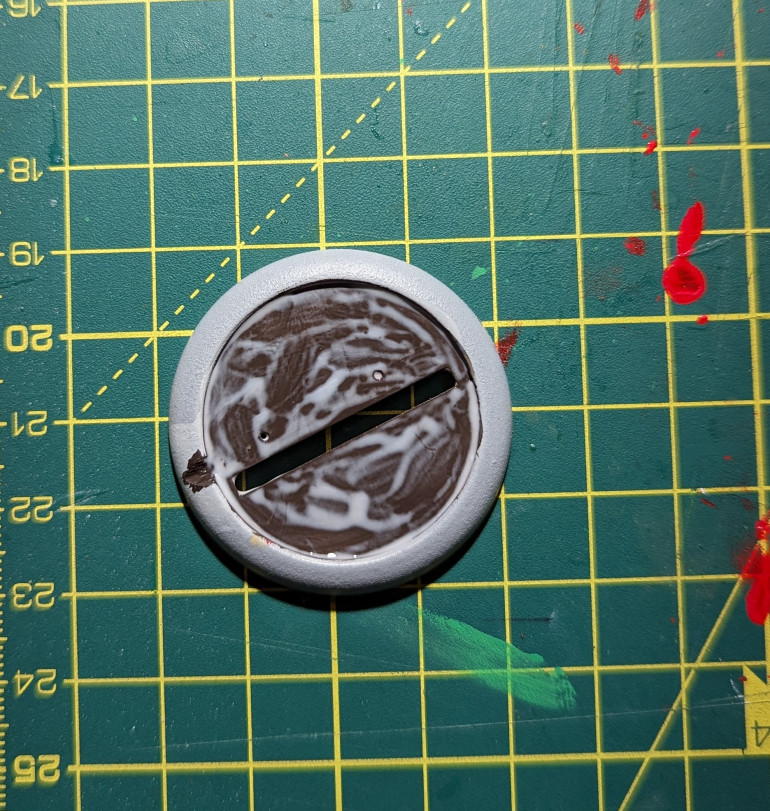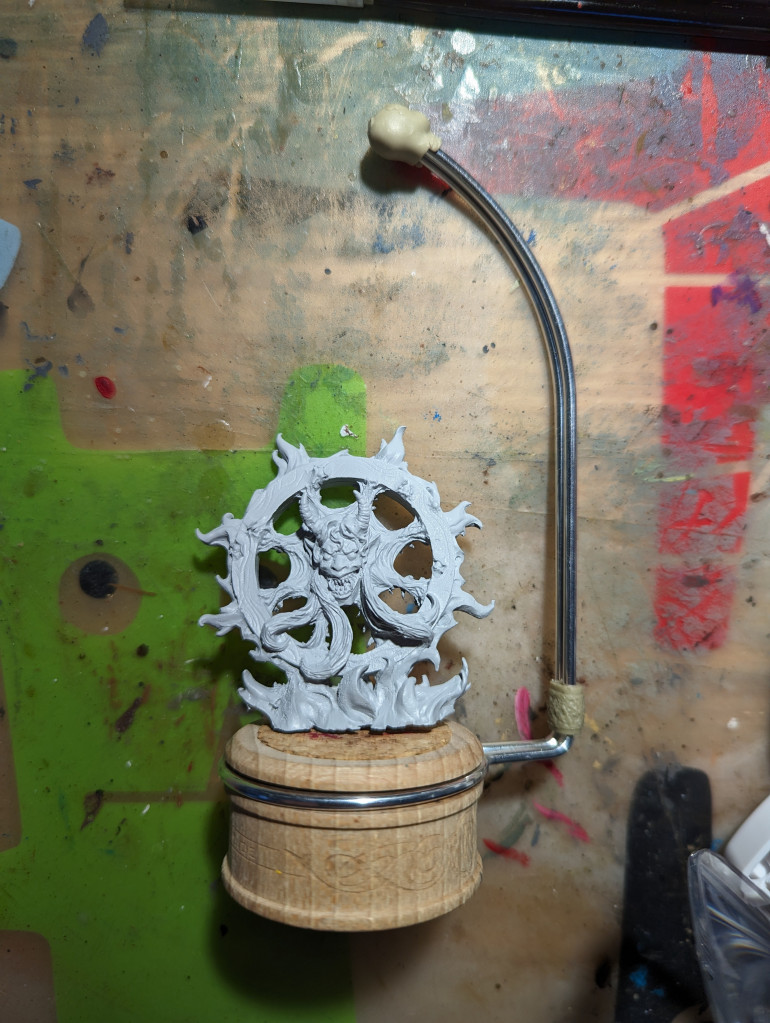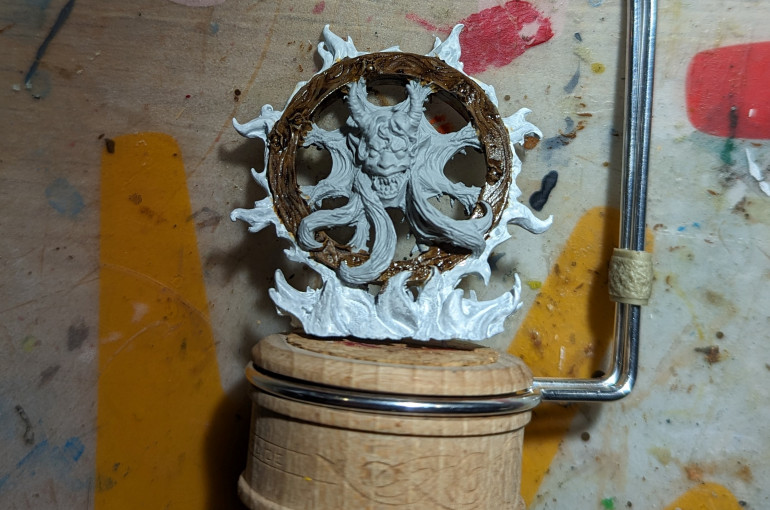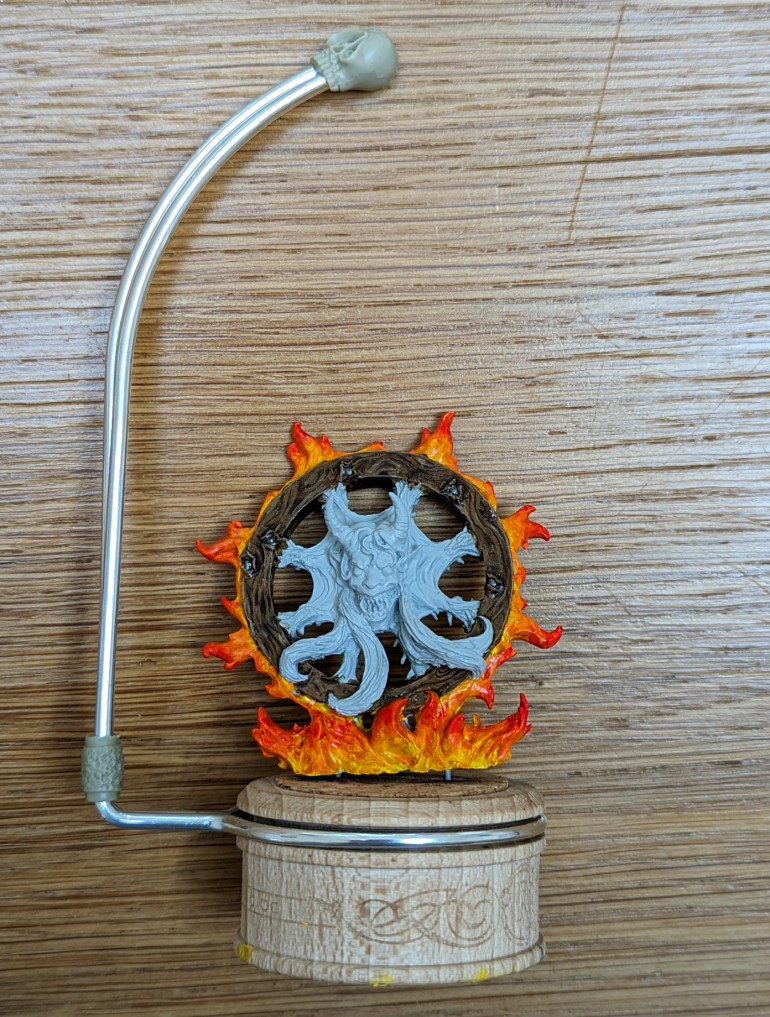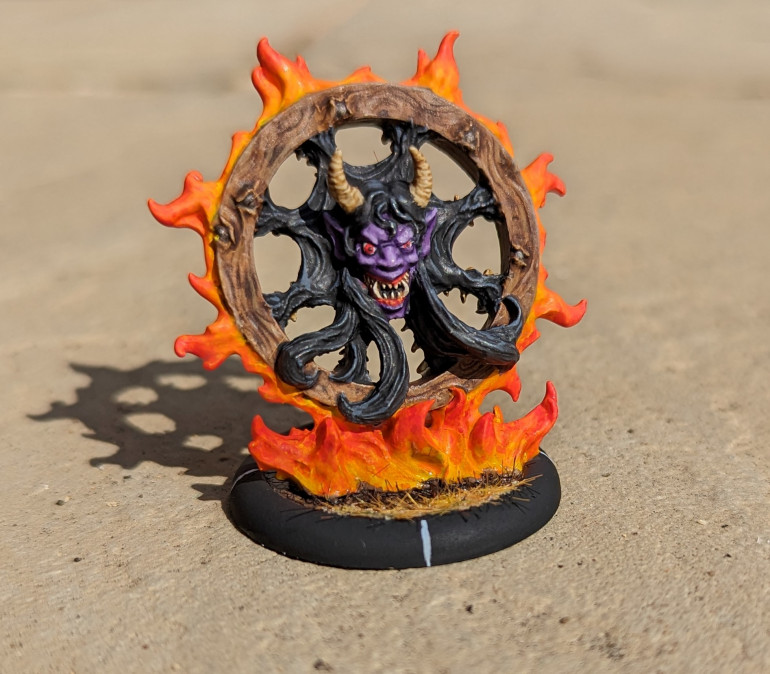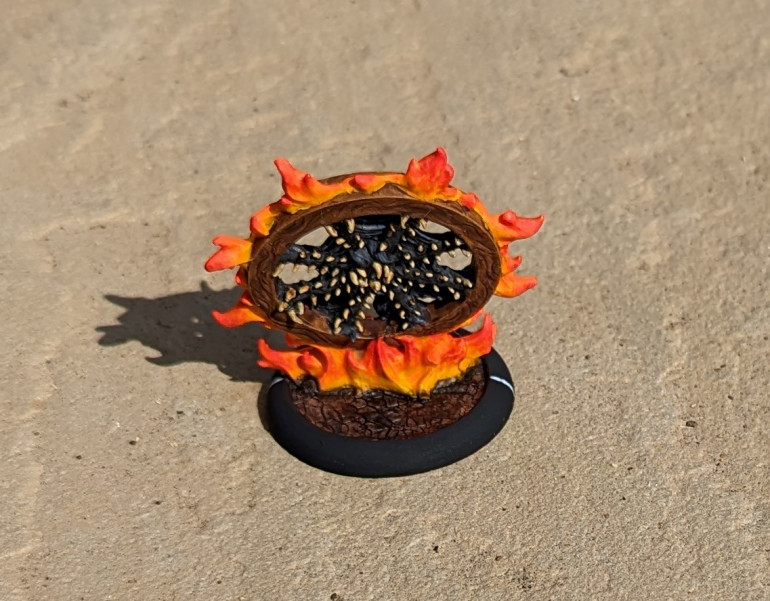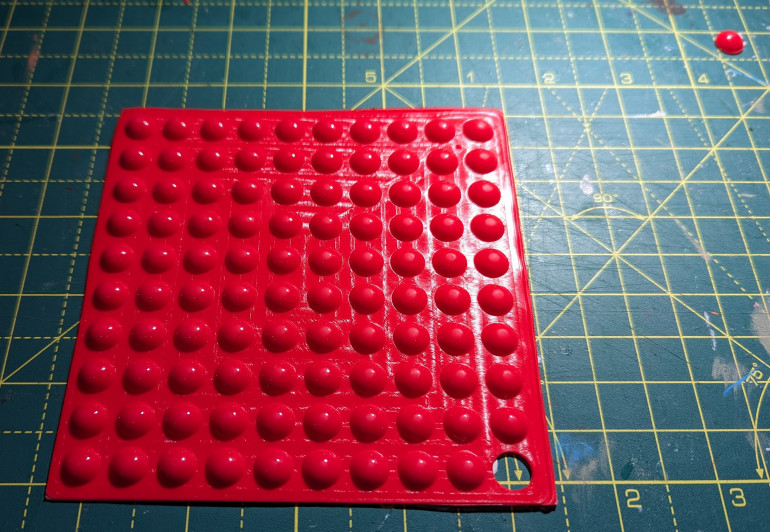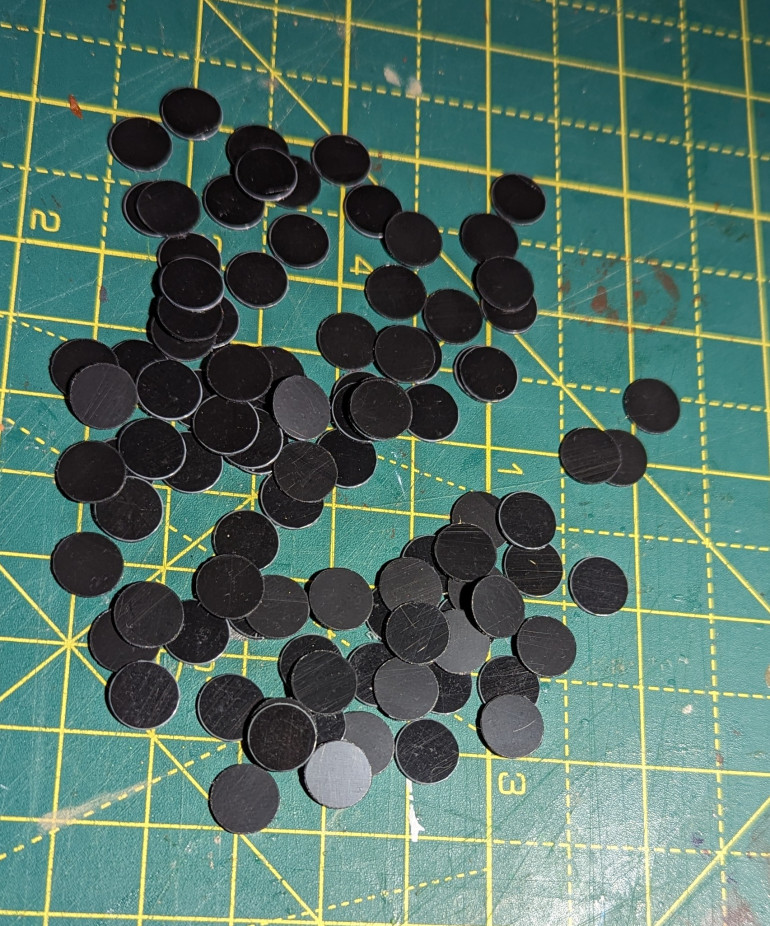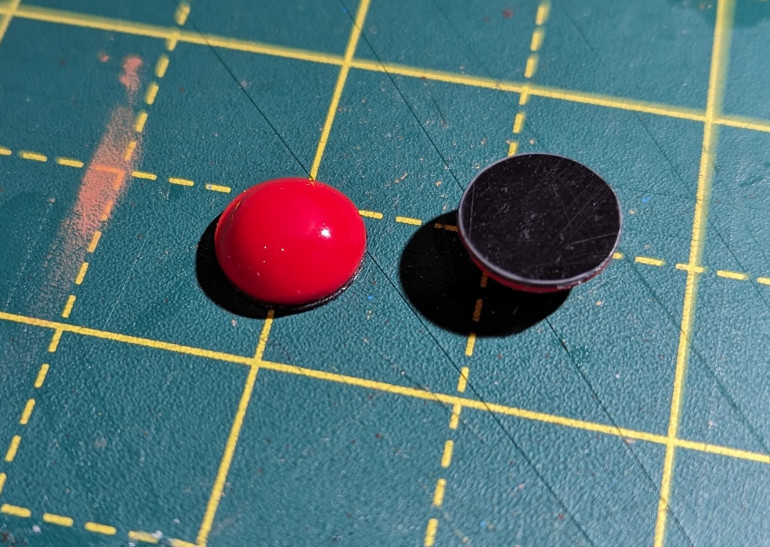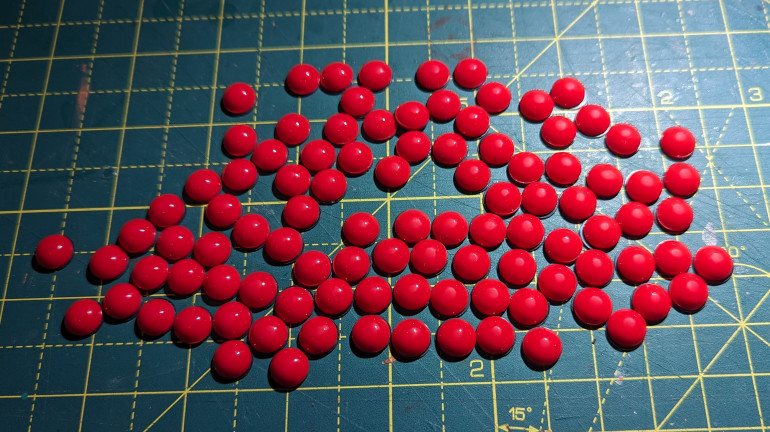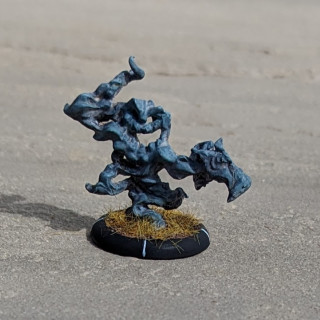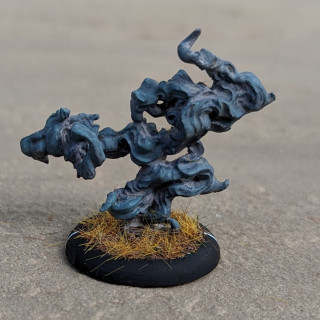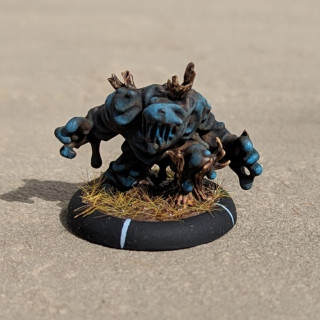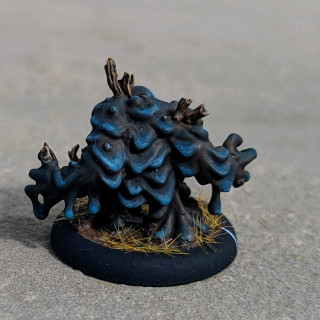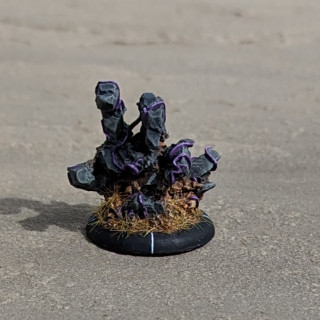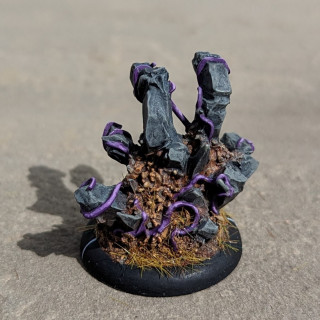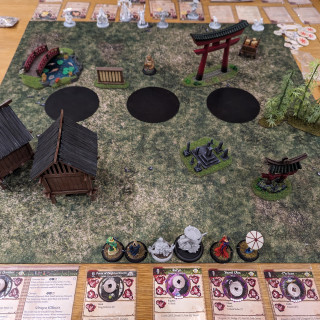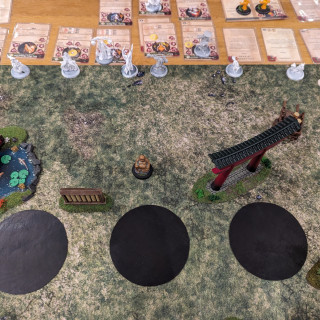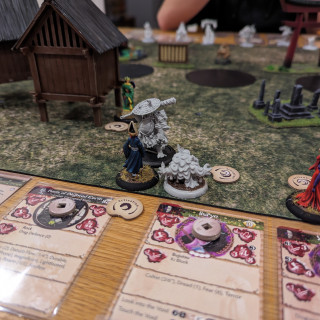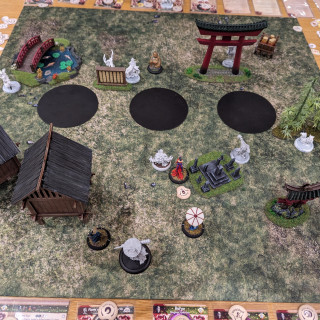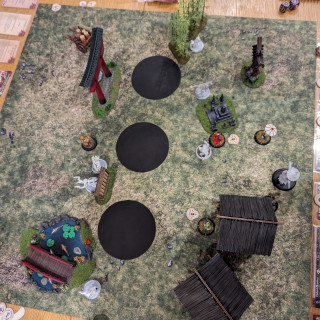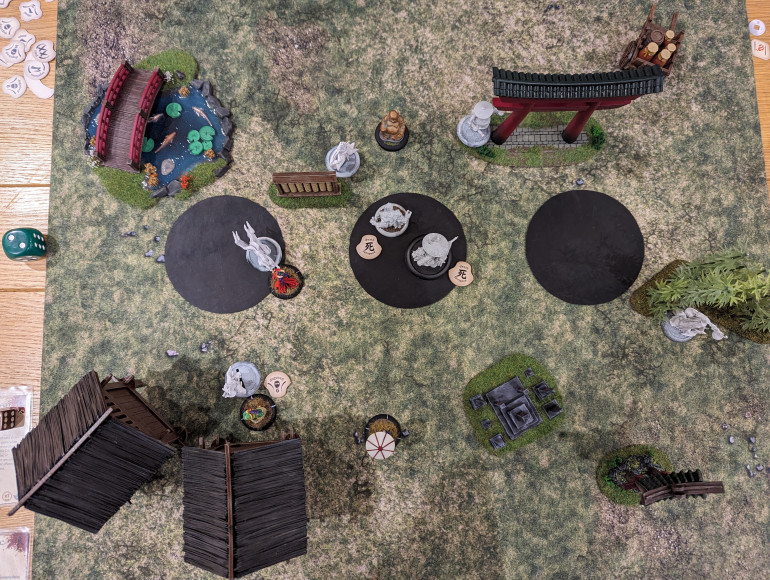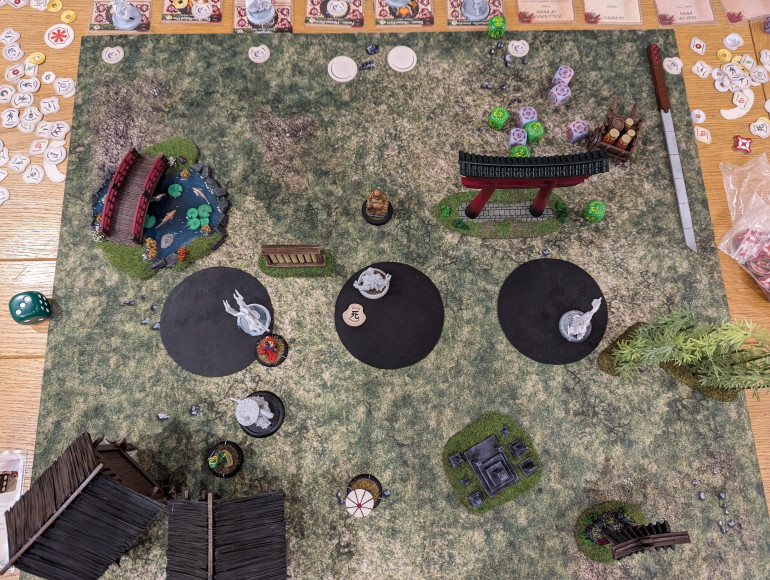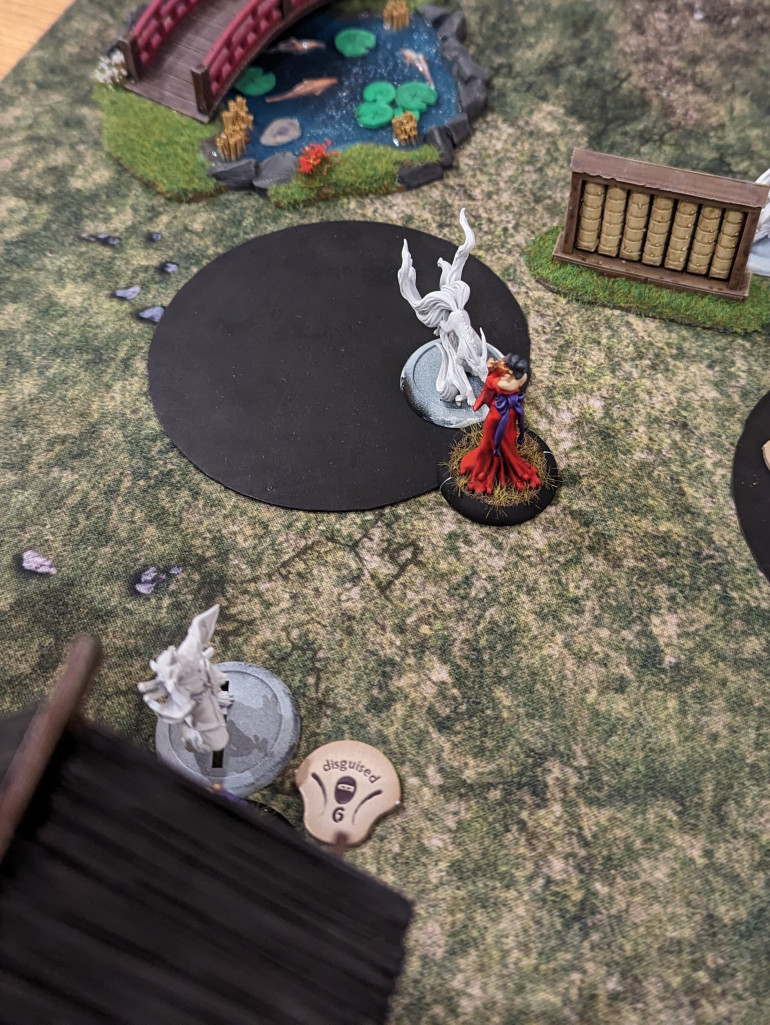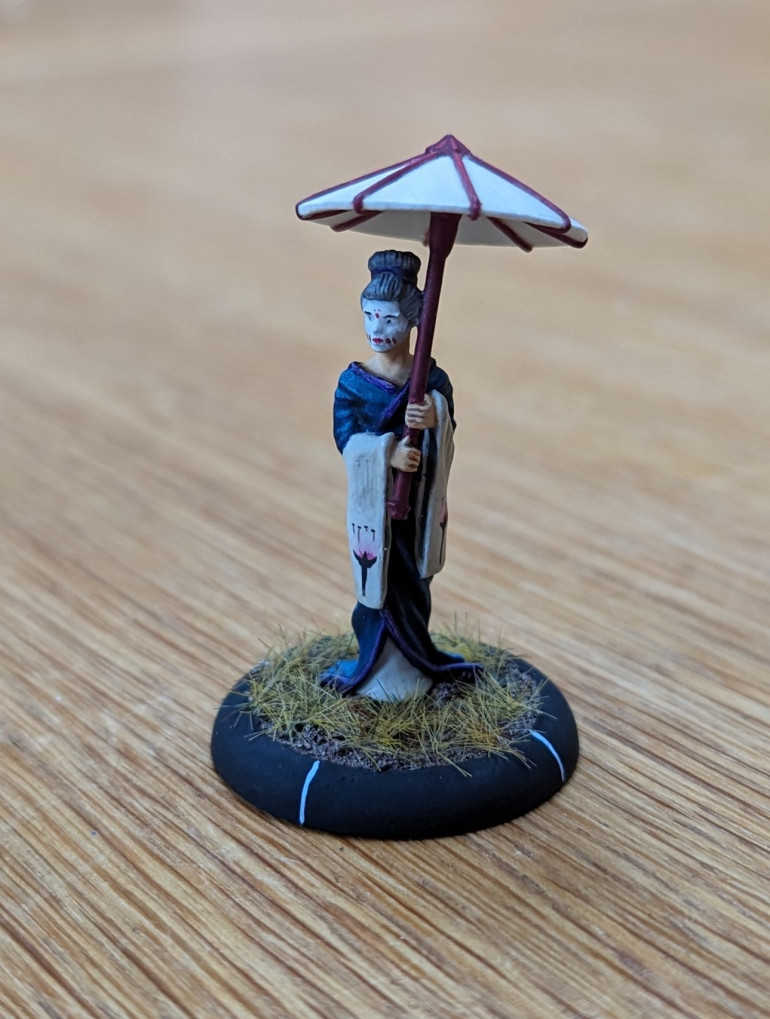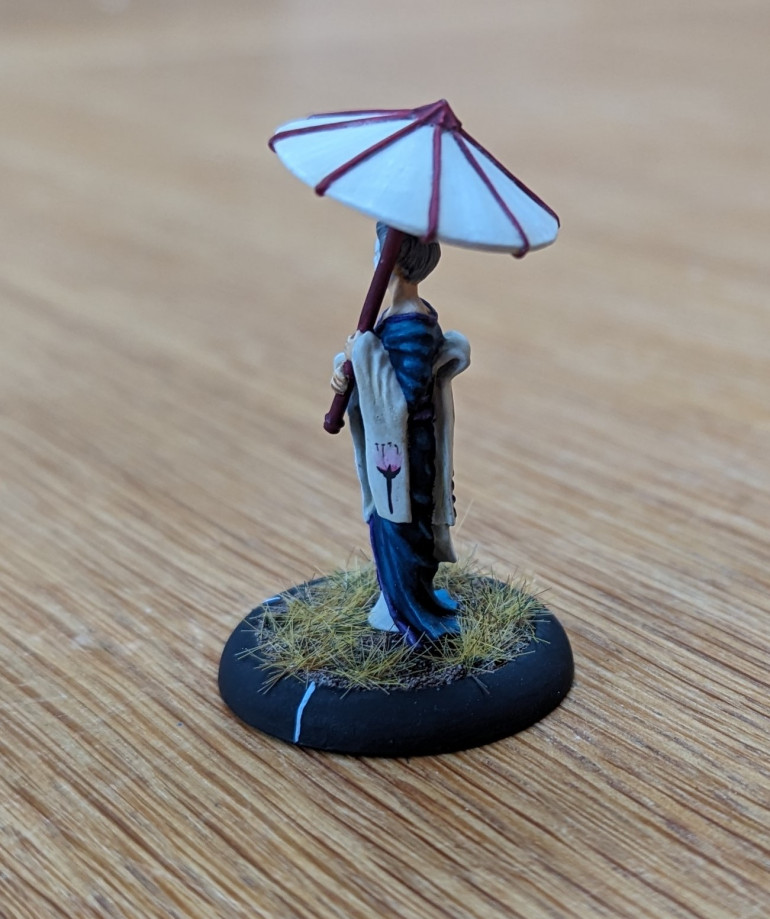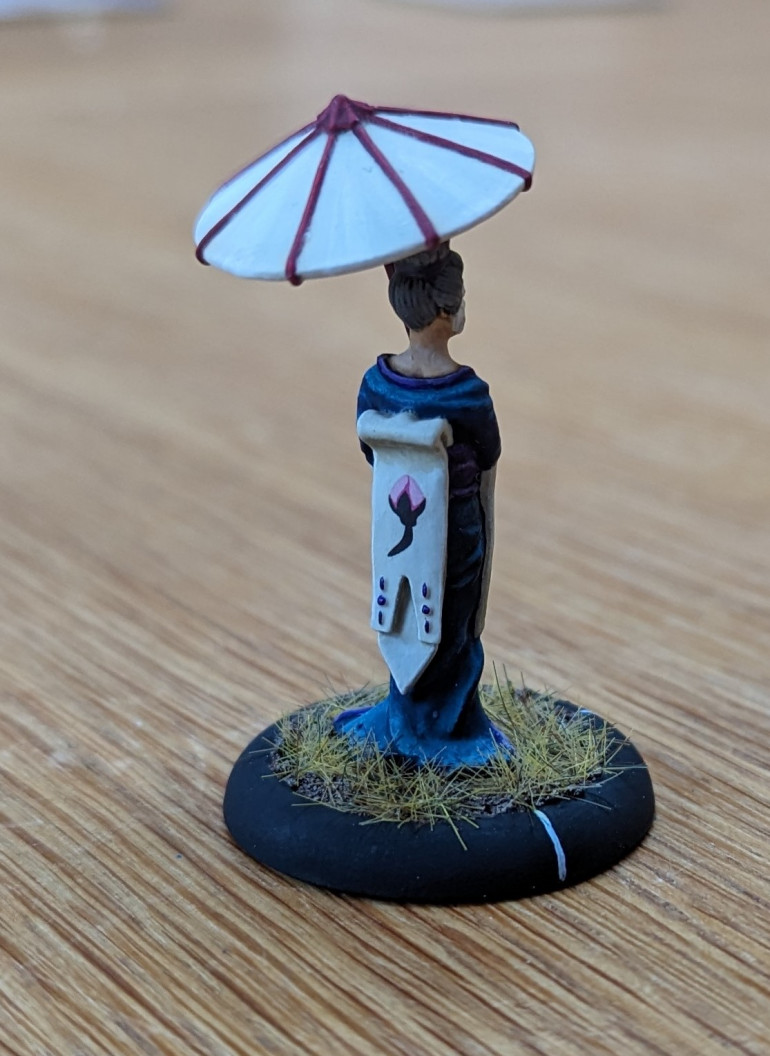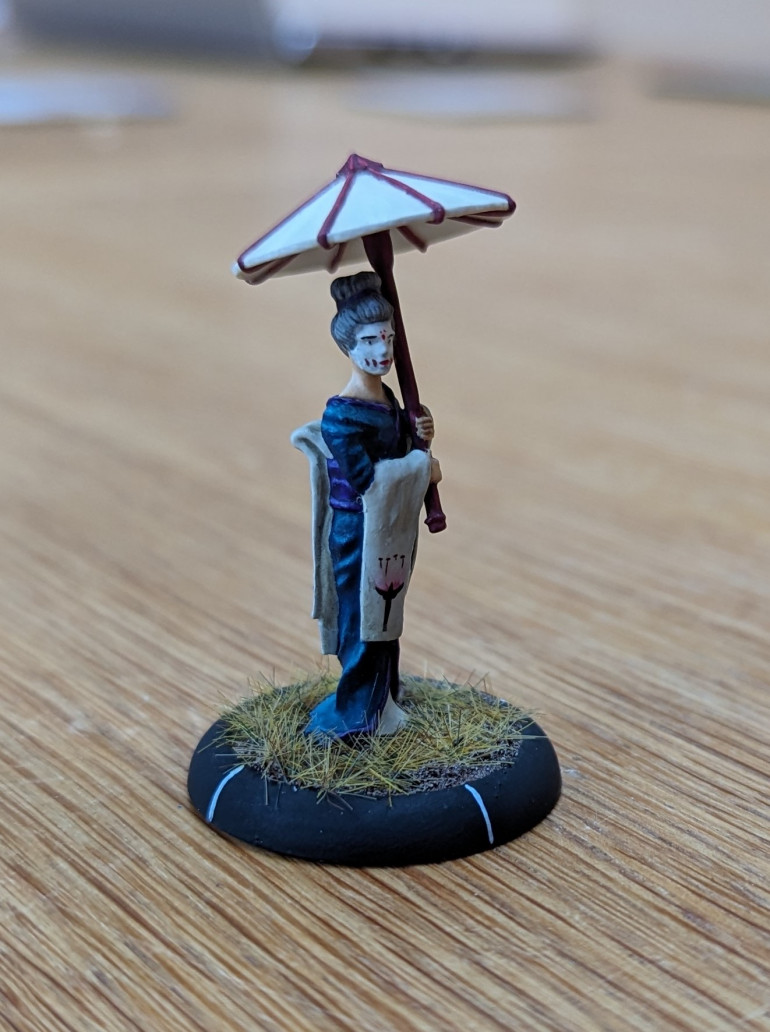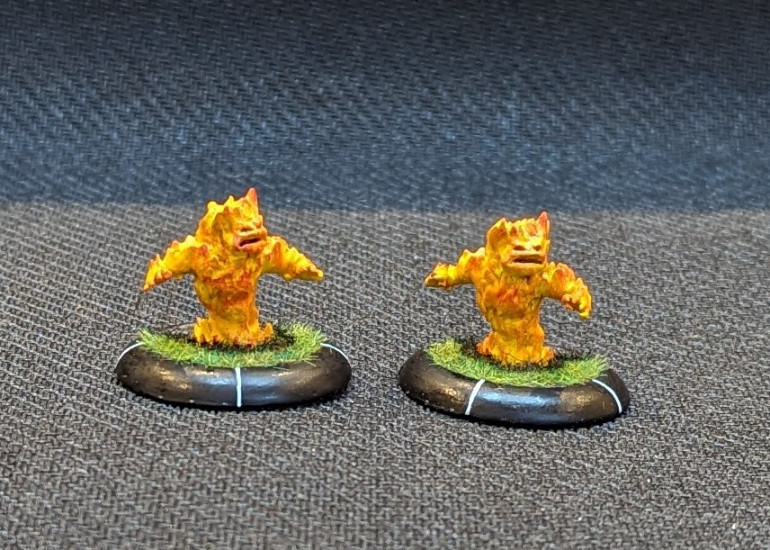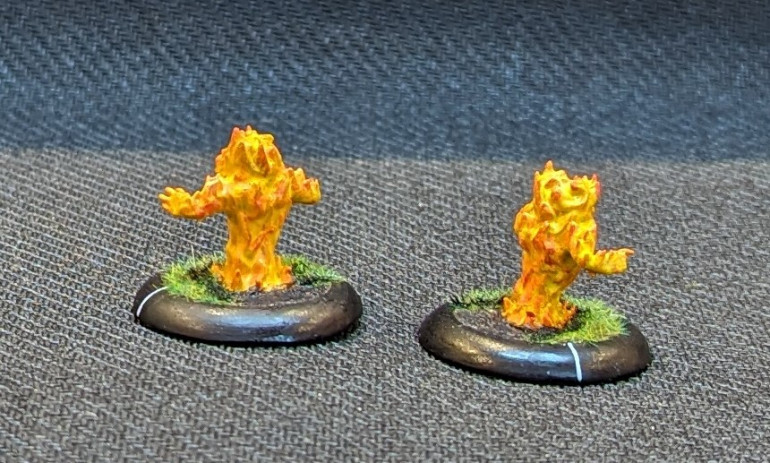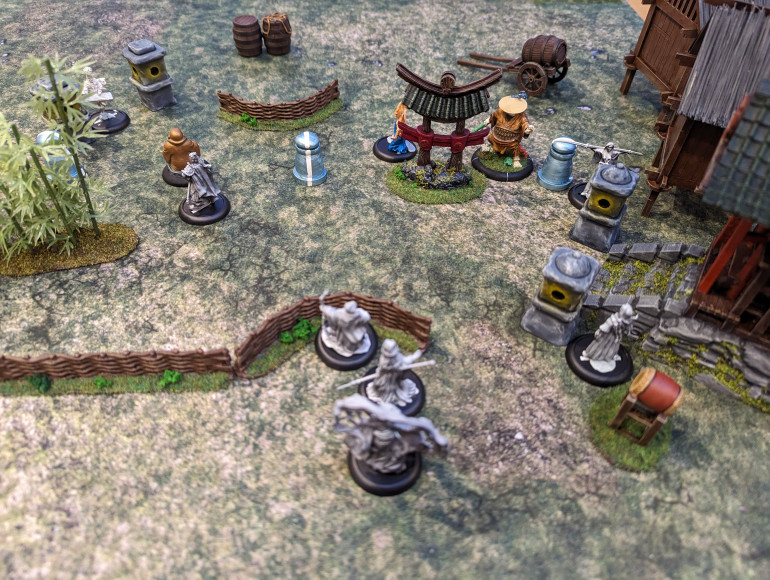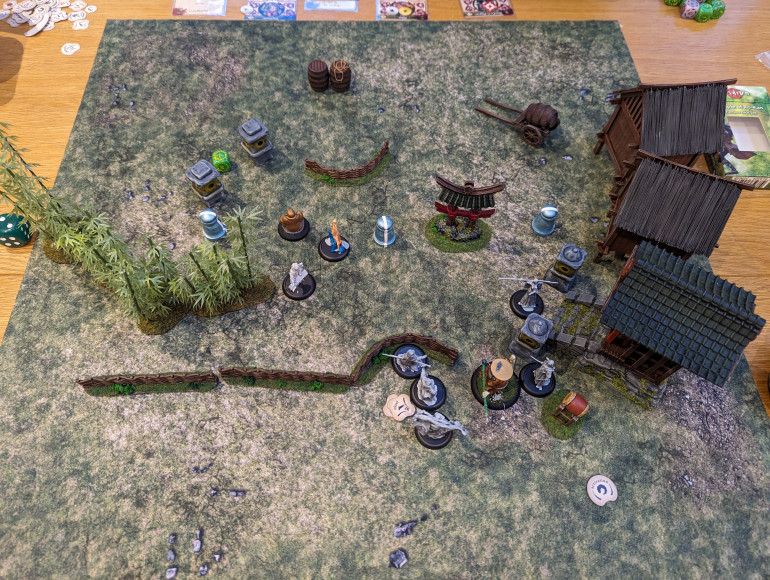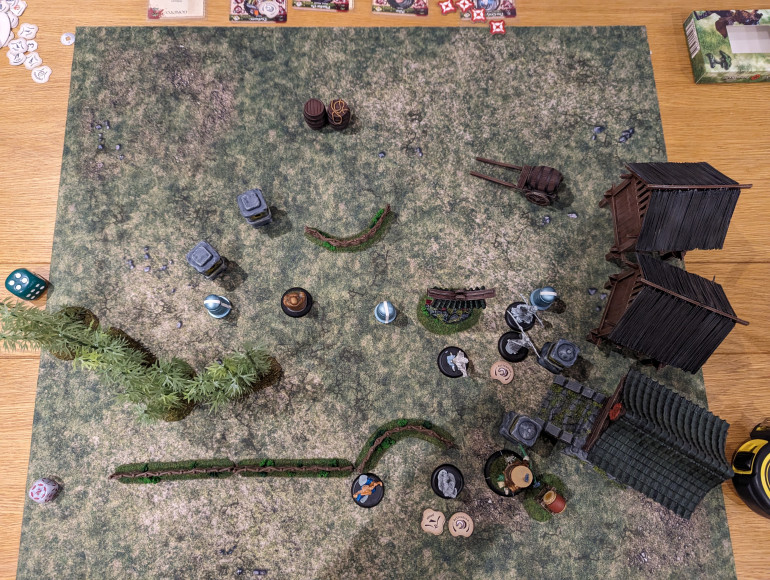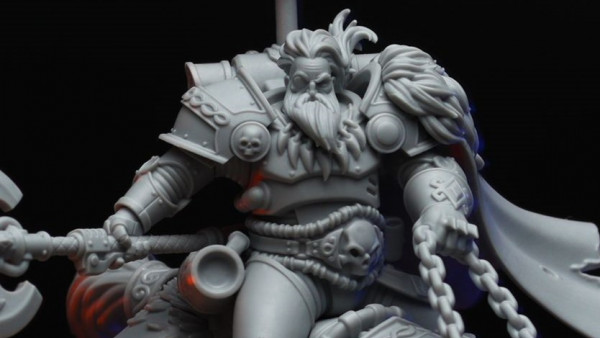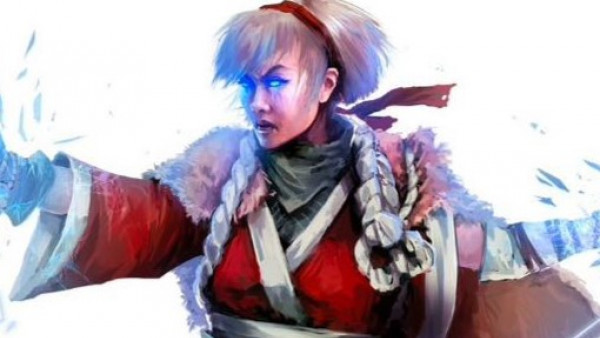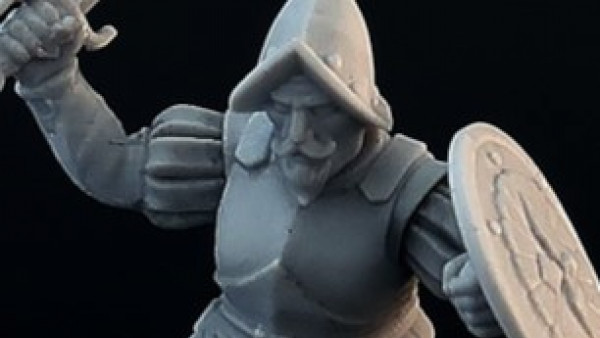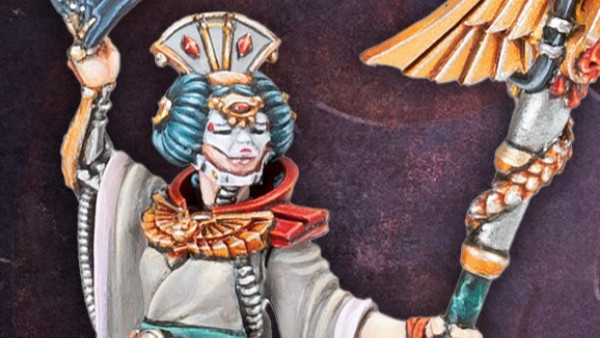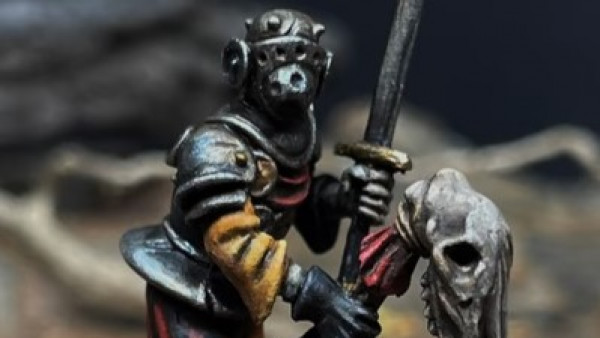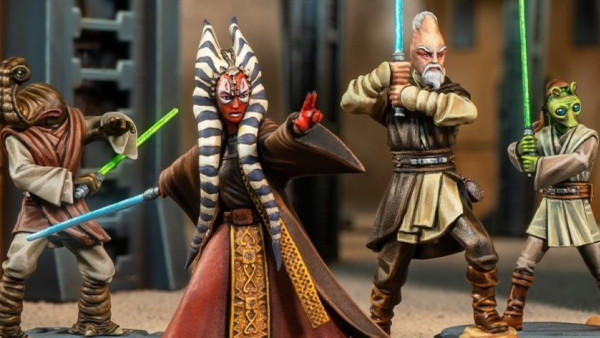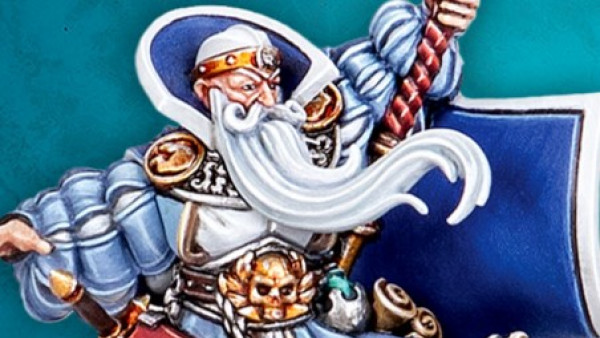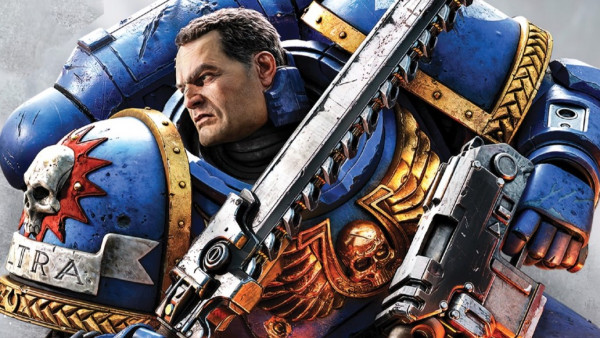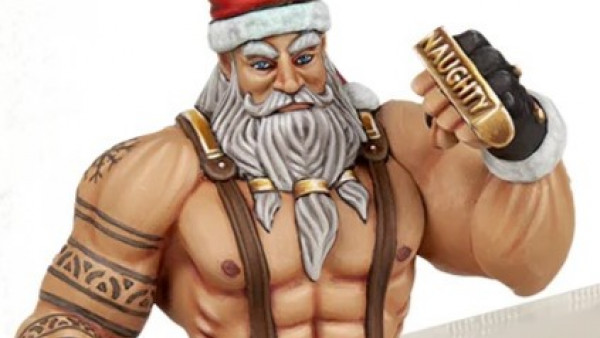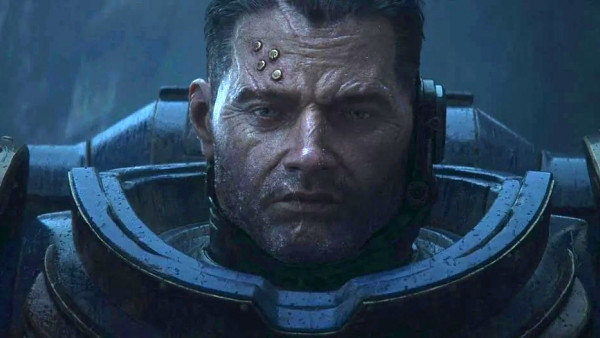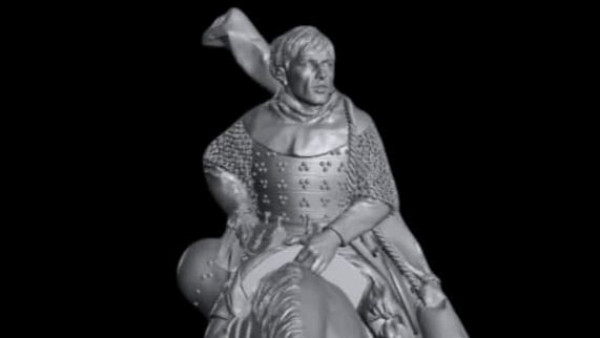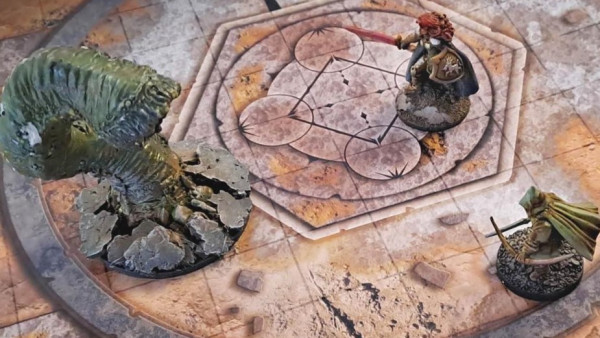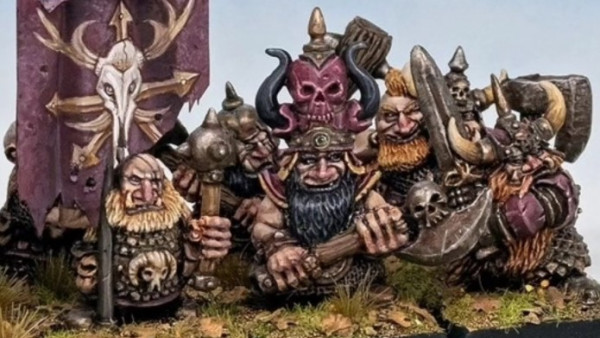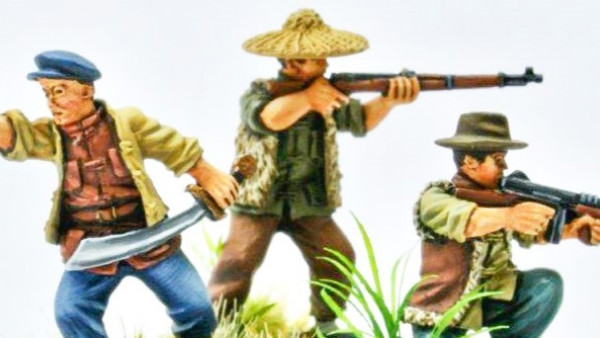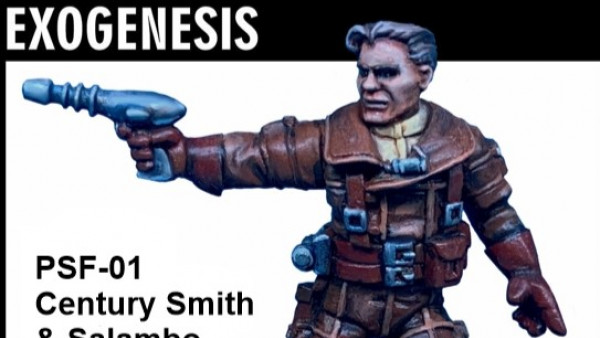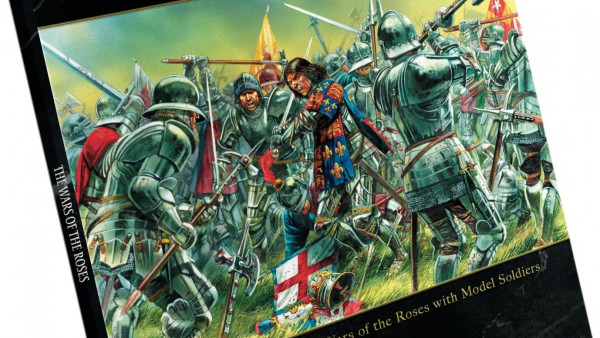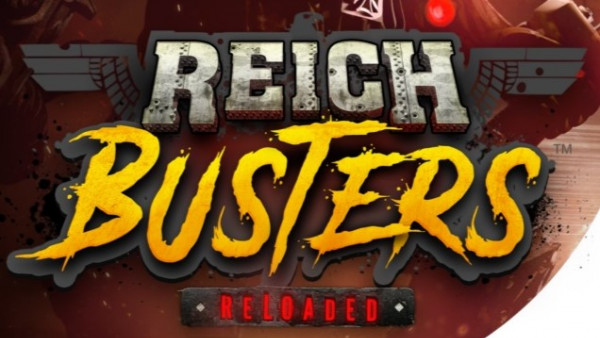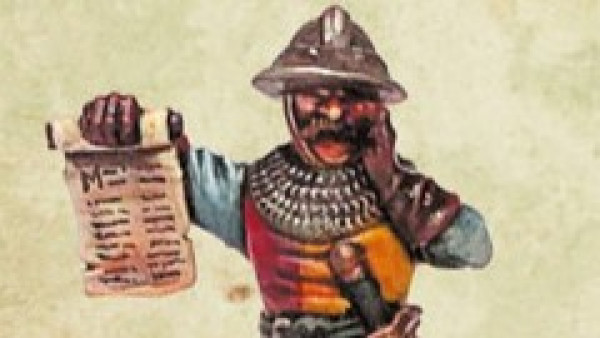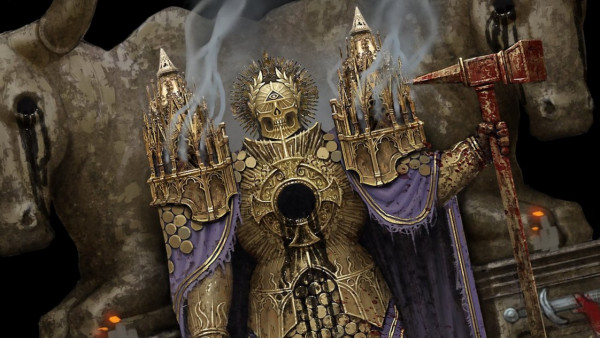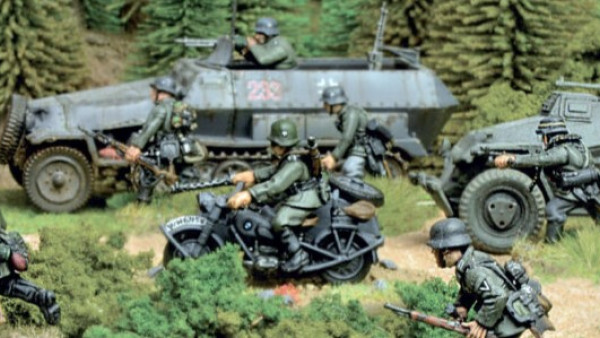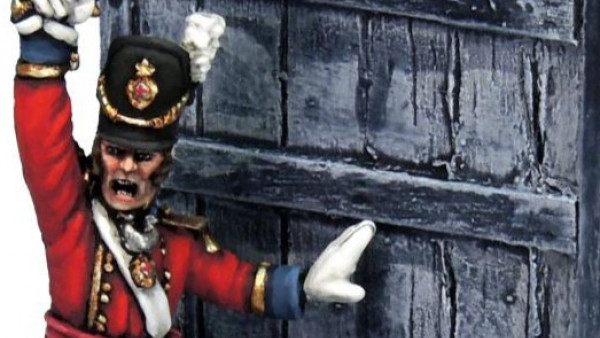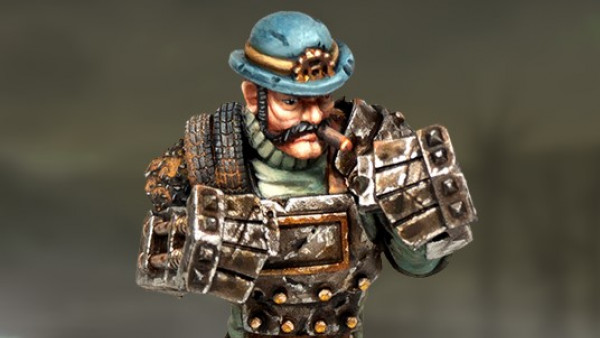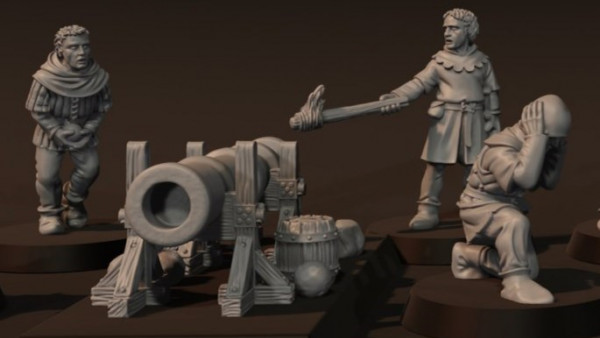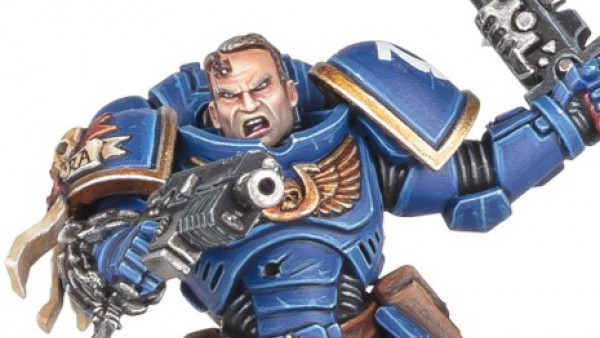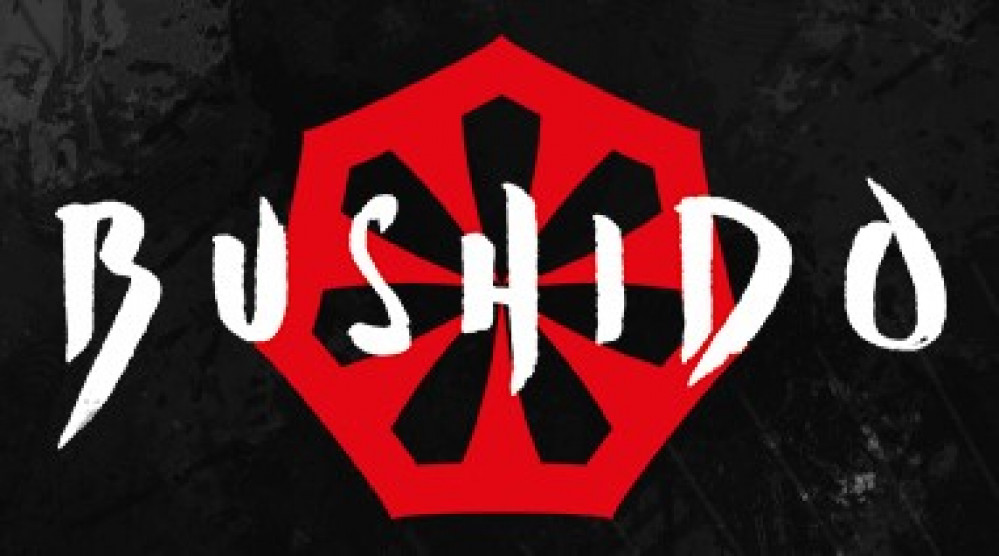
Redvers and Son Get Into Bushido
Recommendations: 1019
About the Project
My son and I were looking for a new game to get into. Something that was low on models, fun and reasonably quick to play. We decided on Bushido.
Related Game: Bushido
Related Genre: Fantasy
This Project is Active
Battle Report No. 10
Game 10.
This game saw my son use his now fully painted Kinshi Temple as he claimed that he has figured out how to play them. As a change, I took his Temple of RoKan for a run out. I wasn’t really sure how to play this faction, but I thought it could be fun.
For my Temple of RoKan (TRK) I had Yim, Haru, Saruka, Riku, Ume and Kosuke. Kosuke is new (the others are described in previous posts in this project but they’re all monks) and an angry ape wielding a massive maul. I also took the Gorinto terrain piece to generate some extra Ki (as TRK monks are all about the Ki).
For the Kinshi temple, my son had Master Shi, Hishigata, a Kami of the Empty Mind, Kodai, Batsu, Ku and Shikaku. He also gets some Void Rifts that his models can pass through giving a lot of extra movement. I would describe what these models do, but I’m not entirely sure I fully understand the Kinshi Temple yet…..
We just went for a straight fight rather than a scenario.
Turn 1.
Kosuke is quick and I wasted no time moving him up the board and getting him in to melee with Hishigata, who had made his way forward. Using Kosuke’s ‘Flow Like Water’ Ki feat and Combo Attack, Kosuke gave Hishigata a significant slapping with that giant maul. The Combo Attack special ability allowed extra damage to be piled on and as Hishigata put no dice in defence, the damage was enough to kill him. First blood to TRK but the death of a Kinshi model does allow my son to add a counter to the Void Card. The more counters here, the more powerful the remaining Kinshi models get…..
Turn 2
As I normally play the Cult of Yurei faction, melee isn’t something that we usually want to get into but having Kosuke is a novelty and I waste no time getting him to take on Kodai. I manage to get some damage down but find out that Kodai is Durable and so this damage is reduced to 1. Kodai on the other hand deals out 6 damage. Ouch.
I use Saruka’s Fireball Ki feat to blast Kodai for 1 damage and set him on fire, giving him a fire token.
My son then used Shikaku’s Ki feat, Look into the Void. I’m aware of this as one of my Cult models has this Ki feat but it’s not so funny when on the receiving end. It’s pretty powerful and Kosuke is killed.
Batsu then uses his Scorched Earth Ki feat to create a burning terrain feature over Ume, so Ume gets a fire token.
Master Shi uses his ranged attack on Saruka and rolls well. It’s a Combo Attack and the extra damage kills Saruka.
It’s not a good turn for me and to make matters worse, Ume takes damage from the fire token at the end of the turn.
Turn 3
Ume gets into combat with the Kami and kills it but this adds more tokens to the Void card and the Kinshi get more powerful. It unlocks new and better shared Ki feats for them.
Master Shi is able to range attack Yim for some damage (again with the pesky Combo Attack being the difference)
Haru then comes in for some attention, firstly from Ku who is able to do some damage and then from Batsu who fails. But Haru is up to the task and causes wounds against Ku and Batsu with some nifty bujutsu.
Batsu is now exhausted, having spent 2 Activation tokens, so I use this opportunity to have Riku attack. This gives me extra attack dice and Batsu gets a firm kicking.
Shikaku again uses Look into the Void, this time at Yim. Yim takes a lot of damage and promptly dies.
Ku now gets in on the Look into the Void act and attacks Riku. This also succeeds and Riku takes damage.
During the end phase, both Haru and Riku have picked up fire markers during the turn and the wounds now take effect. Sadly, they both burn to death.
This leaves me with just Ume. At this point, I’m well and truly beaten and so concede a very one side match.
Seems that my son has figured out how to play the Kinshi Temple…..
Yet more terrain
I put these two models together in 3D Builder based upon some free STL files that I downloaded. They’re both scans of real world statues, in the case of the lone figure, this was from a temple in Bali (and no, I’ve not been to Bali).
First up is just a generic temple statue. I’ve painted in exactly the same way as the previous statues, namely luftwaffe grey, nightshade wash and a light grey drybrush for the stone. The bronze was shiny bronze and then just a nihilakh oxide wash which then gets quickly wiped off.
Next is a Cult of Yurei piece of terrain that can be purchased as part of your warband. In game, at the start of each turn, any enemy model with a couple of inches has to give up 1 Ki point and when you have collected 5, the statue is destroyed and you can give these 5 Ki to any friendly model. Handy.
Painting wise, this is just another bronze and painted in the same way as all the others. It’s quick and easy to knock several of these out in a night.
More terrain
As Terrainfest is running at the moment, I thought I would get some of the extra terrain that I have lying around finished and off of the painting desk. With that in mind, I’ve completed a few pieces that I picked up from Master Crafted https://mastercrafted.co.uk/
First up we have three rice bale stacks. These can be purchased as part of your war band and are very common in competitive games as they can provide cover as well as blocking off lines of movement.
Painting wise, I took the line of least resistance here and went with a khaki basecoat followed by a heavy brown wash. From there, I painted the ropes with a light brown and then just dry brushed everything, first with Khaki and then Iraqi Sand. A quick flock and job done.
Next up we have a prayer rock. This comes in two pieces and required some careful pinning and then I shoved a lot of polyfilla inside it to give it some weight (the sphere is hollow). The base rock was painted luftwaffe grey and, with a break from tradition, rather than a black wash, I applied a nightshade blue wash, which I think I prefer to the black and this might be my new rock wash. A light grey dry brush followed.
The sphere was given a Halfords yellow primer spray followed by a light brown wash. I’ve then dry brushed it with middlestone and Iraqi sand to try to create a sandstone look. The rope was scruffulous brown, with a wash and then highlighted. A light green for the tassels, then a dark green ink and then a very light green dry brush. Flock and scatter added to cover the joins between the two pieces.
Temple Terrain
You can never have too much terrain, particularly ‘dressing’ terrain to help set the scene. To this end, I thought we needed some more temple themed statues. I’d also stumbled across some free scans of real statues that had been converted to STL files. These files needed some resizing and merging as neither the Buddha nor the dragon came on a plinth. Fortunately, this is very easy to do in Microsoft’s 3D Builder tool.
Both statues were painted in the same way. A Luftwaffe grey for the plinth which then gets a black wash followed by a light grey dry brush. The metal is a base of bronze followed by a grey dry brush. I’ve then added GW’s oxide paint which then gets quickly wiped off before it can dry. Finally, a shining gold dry brush.
The jade (which was painted first) was stippled with a sponge with black, grey and white (separately) and then a light green ink is applied over the top via an airbrush.
All of the statues get mounted on a plasticard base that then has some Vallejo acrylic mud smeared over. It’s then flocked and flowers added where appropriate.
Battle Report No. 9
Time for another battle report. We played this using tournament rules and we both had a couple of new models that we hadn’t used before and wanted to give a try.
Scenario. In this game, there are two offset 4” scoring zones that you control if you have more models inside the zone compared to your opponent. Scoring takes place at the end of turn 2, 4 and 6. In addition, we both secretly nominate one of our warband to be our Very Important Model (VIM). At the end of the game, whoever’s VIM is closest to the opponent’s board edge will win a further victory point.
Warbands.
My Cult of Yurei is made up of,
Mokoti, Fuwa Kaidan, Yama Uba, Ibara and the Kami of Blighted Earth (see previous battle reports for details). I’ve also included Rokuro (a tengu with a vicious axe, who’s reasonable in a fight) and the Wanyudo (a fiery wheel who dishes out fire tokens like confetti).
My son has taken Master Po, Kuma, Tsutsumi, Riku (see previous battle reports) and Ashinaga Tenaga (who has a lot of weapon options, including a ranged harpoon that can be used to pull targets around the board).
The initial deployment and table layout is below, including the scout moves that some models are allowed to take.
Turn 1 was quiet and just advancing but we both made sure that we advanced at least one of our models into the scoring zones nearest to our deployment.
Turn 2
I won the strategy test and activated Fuwa Kaidan immediately. I used her Ire Ki feat which is unusual in that it is not an opposed dice roll but rather an automatic success. The Ire feat on an opposing model causes them to become Beserk, which means that they activate next (hence throwing your opponent’s plans out the window) and the have to attack an opposing model if they can. In this case, Ire also causes the targeted model to treat all models as opposing models! So good positiong from Fuwa Kaidan can make your opponents best model attack another of their models – amusing Cult schenanigans! The downside is that this costs FK 2 of her 4 life points, but she can regain these and if she loses all of them, she respawns anyway, so no big deal!
In this case, I managed to get into position to get Fuwa Kaidan to give Kuma Ire. That was the end of my turn but my son had to activate Kuma next and attack the nearest opposing model which just happened to be Tsutsumi. In this instance, kuma failed to cause any wounds but both Kuma and Tsutsumi both lost an activation counter, so very useful from my perspective!
My son then activated Kuma again and used him to attack my Blighted Earth Kami. He spent some of Kuma’s Ki to buy another attack dice and also activated Kuma’s Combo Attack special ablity. Most Kami’s have Durable, which means they can only ever take 1 wound in any attack but Combo Attack gives the possibility to cause multiple 1 wound damage against a Durable model. Smart thinking and it worked as Kuma used his ability to kill my Blighted Earth Kami.
With Kuma now exhausted (and therefore automatically losing 1 dice from his melee pool) I wasted no time in getting The Wanyudo to charge into Kuma. Kuma is so good in combat that my initial attack does no damage and Kuma is able to hand out 1 damage to The Wanyudo but Kuma does pick up a Fire marker, which if not dealt with by the end of the turn, will cause Kuma 2 points of damage.
My son passes and I’m then able to use Ibara’s Dark Fire ability to add a Fire marker to Tsutsumi.
Master Po leaps into action and attacks Rokuro. My son uses a lot of Ki to boost Po and use some special attacks. These are no match for Rokuro as Master Po is much better in combat, but time for schenanigans! Before any damage roll, Rokuro can use upto 3 Ki to negate the same amount of damage and pass that damage back to the attacker. This is exactly what I do, and Po deals out 4 damage in total but I’m able to deflect 2 back on Po, so effectively honours even! I laughed, my son made comments about this being over powered.
Po attacked again and used his Counter Strike Defence in conjunction with his attacks to overwhelm Rokuro and kill him. So I guess my son had the last laugh here!
In the final stages of the turn, Riku used his Tsunami Ki feat to push Yama Uba back 8” and well out of combat range. The Wanyudo used it’s Inferno Ki Feat to put down another Fire marker on Kuma and Ibara again used Dark Fire to add a Fire marker to Kiku (although Kiku was able to remove this by using an activation on a Wait action).
At the end of the turn, Kuma, Tsutsumi and Riku all took damage from their fire markers!
Turn 3.
I again won the tactical roll off and went first and yet again used Fuma Kaidan’s Ire Ki feat but this time on Tsutsumi. This didn’t really have any effect as Tsutsumi didn’t cause any damage on their attack but at least it wasted an activation. FK though was out of Ki and effectively ‘dead’ but respawned back at her pot terrain marker, so no major issue for me.
The Wanyudo was still in BtB with Kuma and was able to use Push Defence in combat to push Kuma out of the scoring ring. This doesn’t cause any damage but does enable you to place the enemy model further away – useful for controlling zones in a game where this is important.
Master Po manages to get round to Mokoti, who I have left open on the flank. This is really not a fair fight and Mokoti gets heavily slapped, taking 4 wounds.
Ibara again uses their Dark Fire Ki feat to add a Fire marker to Riku.
Po again attacks Mokoti and it’s all over for the pipe playing monk as he is kicked to death by the chubby Master Po. I’m now down to three models, which is worrying.
I’m now getting a little desperate, so I use Ibara to attack Tsutsumi but this results in s stalemate.
Riku, still on fire with the fire marker, is able to then attack Ibara and with some phenomenal dice rolls, kills Ibara. I’m now down to four models. Ouch.
I’ve moved Yama Uba back after she was pushed away and she is now back in the fight. I move her into combat with Riku and use her morph ability to copy Riku’s four attack dice. She then uses her newly morphed 4 melee dice to attack Riku which goes abysmally and Riku slaps Yama Uba for 4 wounds.
But, despite losing 4 models, I currently control all of the scoring zones and collect 1 victory point, so I’m winning!
Oh, and Riku takes some fire damage.
Turn 4
After winning the strategy roll again, I charge the Wanyudo into Kuma using his special slam attack. This is successful and while Kuma doesn’t take any damage, he is shoved further back and also picks up a fire marker.
Kuma is having none of this and attacks the Wanyudo back but fails to cause any damage.
Master Po attacks Yama Uba and, being the combat monster he is, is able to hand out two slaps. Ashinaga Tenaga, who’s been remarkably quiet so far, joins Po (and Riku, who is still in BtB with Yama Uba) to hand out yet more damage. Finally, Riku (still on fire!) deals the final blow to Yama Uba and kills her.
I use Fuwa Kaidan to use Ire on Kuma who then attacks Tsutsumi and deals out some useful damage. The cost of Ire causes Fuwa Kaidan to die again and she respawns back at her pot.
Annoyed with the constant respawning, my son uses Ashinaga Tenaga to destroy the pot, which will remove my ability to respawn Fuwa Kaidan should she die again.
Ashinaga Tenaga then attacks Fuwa Kaidan, doing a solitary damage to her (but as she only has 4 to start with, that’s not good!)
The Wanyudo, sensing an opportunity, uses its Inferno Ki feat, which sends out a fiery blast zone, giving everyone in the zone more fire markers! In this case, Kuma, Tsutsumi and Riku (again) all get a lovely fire marker (a level 2 fire marker in this case!)
Riku, the human bonfire, attacks Wanyudo. Sadly I manage to roll double ones and Riku is able to slap Wanyudo for a wound.
To really turn the pain on, Kuma attacks Wanyudo and is able to hand out some serious damage and destroys the fiery demon.
As my son’s final action, he uses Ashinaga Tenaga to attack Fuwa Kaidan to kill her and as her pot is now gone, she can’t respawn and permanently dies. This means I’m now out of models and wiped from the board.
But, we still have to close out the turn and first up is handling the fire markers. Kuma, Riku and Tsutsumi are all on fire and have plenty of fire markers each, enough to kill all three of them, which leaves my son with Master Po and Ashinaga Tenaga.
Next we see who is controlling the scoring zones. It’s not going to be me, as I have no models left and fortunately for my son, he has Po in one zone and so scores 1 victory point, so the scores are level.
Interestingly, in Bushido, you don’t automatically win if you table your opponent. When this happens, you finish the turn and then stop the game. Whoever is ahead on Victory Points, wins. In this case, we’re tied on 1 each, so we then looked at who’s VIM was closest to the opponent’s table edge. But, both our VIMs lay dead on the field and so, much to my son’s bitter complaints, the game was a draw. He didn’t like this, I did and I’m the adult, so the result stood – an honourable draw.
Rokuro
Rokuro is a tengu who has fallen in with the cult. He (I’m assuming Rokuro is he) comes with two axes which can be used as ranged weapons (just two shots obviously) or in melee where he gets the brutal and bleed special rules while he still has the axes. He’s not bad in combat and the brutal rule definitely adds to his ability. He’s also a bigger model and based on a 40mm base rather than the standard 30mm.
Painting wise, the skin was based upon the darker tones in my skin paint set, using the ‘Indian shade’ extensively to darken it down. This was applied as a glaze to try and smooth over the transition. I’ve used a khaki on the trousers, using an off white khaki mix for the highlights and a shade of khaki and dark brown mix applied as a glaze. The purple sash was imperial purple mixed with black/off white for the highlights and shades.
The armour and axe blades is gunmetal and I’ve then applied a couple of black washes over the shaded parts, building this up into the darker areas. I’ve then used gunmetal to highlight back up and finished off the edges with a polished metal.
The axe handles are bleached bone with a wash applied whereas the hair is Luftwaffe grey with a black wash and then a light grey dry brush.
The wings were a combination of browns, including cavalry brown as the base and a highlight of light brown. Similar for the feet.
For the basing, I’ve used the usual approach as I have for my other cult models. I’ve also stuck some brush bristles on for some height in the vegetation.
Job done, and ready for the gaming table.
Update on my Son's Painting
My son and I made our inaugural visit to Salute earlier this year where we made a direct line to the GCT Studio stand. My son wanted the Kinshi Temple faction which is a fairly new addition to the game. It’s a small faction where all but two of the models are within the faction starter set, so my son picked up all of them. He also picked up two of the Kami of the Empty Mind which can also be added to a Kinshi Temple warband.
He’s now managed to paint them all, so below is the complete Kinshi Temple faction painted and ready for battle. Painting is not something he really enjoys and he has quite a shaky hand, so he finds the finer details quite challenging and frustrating. He used the Army Painter speed paints and because they are very easy to use, he was able to complete the models quickly and, as a consequence, gain some motivation in getting them completed. By the end, he was quite enjoying the painting process and pleased with his results.
Having completed the above, he also tackled Ashinaga Tenaga. This model was a feature of a previous update here as it is a real pain in the backside to put together. It’s a metal model and the contact points are very small and therefore some very careful pinning was in order. It took several hours just to get it ready for painting.
My son again used mostly speed paints for this except for the skin, which was an acrylic from my skin paint set. I think he painted this in an hour or so and then left it to me to base it up. He’s a lot quicker at painting than I am.
Dohyō
At Salute this year, while wandering past the TT Combat stand, the Eastern Empires mdf terrain called out and when I got home, I found that I had purchased a dohyō ring. Not sure how that happened.
The model took some time to build but went together fairly easily. The one area that I did want to change was the actual ring. The model has some small mdf plugs to mark it out but real sumo rings have rice straw bales, so I will replace the plugs with string instead.
Once built, I sealed the whole lot with two coats of mdf sealer before applying a primer.
The stones making up the base were flat and required some texture. I blobbed on some artist gesso for this which is fine enough to not look silly but has enough texture that it will dry brush well.
Painting wise, as terrain, you want to make it look good, but not spend ages on it. The stones round the base were Luftwaffe grey and then dry brushed with a light grey. The mortar was painted Iraqi sand (as was the actual sumo ring) and then given a brown wash. Given the large expanse of the roof and pillars, I used cheap acrylic paints on these to save some money.
The roof is flat but I wanted to create a ridged tile effect. The tiles had been engraved onto the roof but without any profile, it looked a bit off. To create the profile, I’ve painted what would be the ridge with a lighter green and where the ‘valley’ of the tile meets the ridge, a darker green. I’ve varnished the roof with a gloss to further try and recreate the glazed tiles found in Japan and China. The last step was to airbrush some sun yellow around the lantern to try and create a glow effect.
A bit of flock to recreate moss around the base helps set the terrain onto the table.
The fences were very quick, no shading and I couldn’t be bothered with dry brushing – life it too short.
Two Lone Swordsmen
Taking the Two Lone Swordsmen (TLS) in the game gives you two models. Points wise, they aren’t cheap, potentially being a quarter of your warband but they are very annoying for your opponent. In game, they are fairly average at combat and movement but do get to activate as a pair but are treated as two separate models. You need to be a little careful as you have to assign the same activation to both of them but this just encourages you to keep them together. In combat, they gain an advantage with their Coordinated Attack which gives them an extra attack dice, this in itself ups them from being average, to being good. They also have the Prowess special rule, which allows them to re-roll a melee dice each combat should you not be happy with the result. Their armour of 2 also reduces the damage coming back in return.
But the real bonus is their special rule of Linked. If a Lone Swordsman is killed, at the start of the next turn, you may place them back on the board in btb with another Lone Swordsman and with full wounds. Therefore, the only way to kill TLS is to kill both models in the same turn. This is quite hard to do and results in the delightful effect of having them respawn.
The small downside to all of the above is that they are Ronin and to recruit them into the Cult of Yurei I need to give up a Themed list option and the benefits that this would have given me. Still, it will be worth it to see my son’s reaction when they keep coming back after being killed!
Painting wise, I’ve gone simple and quick. After the standard zenith highlight base, I’ve used a black speedpaint for the robes. The armour is a gunmetal given a nuln oil wash and then a gentle chrome dry brush. Skin was a light skin tone with a wash applied and then highlighted back up. I applied a blue sash to provide some colour and was a mid blue followed by a blue wash. I’ve then highlighted back up. The cord was scruffulous brown with a wash applied.
I wanted to make them look a little road weary and so once the paint and varnish had dried, I applied a couple of thin coats of enamel dust over the lower parts of the robes, with each coat being applied over less of the robe to try to fade it down to the bottom. It wasn’t overly successful but I’m fairly new to the enamel washes, so you lie and learn. To round out the model, I based it in pretty much the same way as my other models to try and create some uniformity across the warband.
All in all, a quickish job.
Fuwa Kaidan
Kaidan in Japanese is two words, kanji, that means mysterious apparition and dan, which means a narrative. But generally, it relates to horror and ghost stories and the creatures in those stories. In this case, Fuwa Kaidan is a ghost and the model comes with a terrain piece, the Tsuridourou or pot. You get to deploy both in game.
FK has some drawbacks, notably speed which is only 3″ but this can be boosted by spending 1 Ki for each extra 1″. FK also only gets to roll 1 melee dice, which is frankly dire, so you don’t really want to be getting into combat. The model is also a Kami which means that FK doesn’t have a wound track but instead it’s Ki is effectively its wounds. It always deploys with full Ki (in this case 4) but of course any Ki feats it uses burns up this Ki (and therefore its health!).
So why take FK? Well there are plenty of upsides here. Firstly, when FK reaches zero Ki, she re-deploys in BtB with the pot or any friendly scenarion objective. Only if the pot is destroyed, can FK be destroyed. So she is a gift that just keeps on giving. She also has a 4″ ranged attack that, if successful, removes a Ki from the target and FK gets it. She;s Durable, meaning that she can only ever take 1 wound per damage roll and is intangible, allowing her to move through terrain and leave BtB without penalty.
But you really want her for her Ki feats. Firstly, if she does get engaged in melee, she can spend 2Ki to cast Mirage that, if successful on the die roll, she gets to deploy 2″ away and the attacking model finishes its turn. She can cast Blind – normally, such Ki feats require an opposed roll but not here, it’s automatic. The enemy model gets a Blind marker which means that it should be surprised by any incoming melee attacks and will therefore lose 1 melee dice. So a great way of debuffing an enemy model before you bring in your heaver hitter.
I’ve saved the best to last though. For 1 Ki, you can cast Ire on an enemy model within 4″. Like Blind, this is automatic, with no dice rolls! The enemy model gains the Impetuous and Berserk traits. Impetuous requires the model be activated before any other model on the enemy warband. Berserk requires the model to attack the nearest enemy model, but here’s the good bit, Ire makes all models on the table enemy! Assuming you get your positioning right, the berserk model will attack one of its ‘friends’, so both models will lose an activation and you have the possibility of one causing damage to the other. And the fun doesn’t stop there, any damage caused, FK gets to restore 1 Ki! FK is rapidly turning into my favourite model.
Painting wise, the pot was fairly straightforward. I’ve used a silver grey as the base and then applied some light brown glazes under each rim to create shadow. The smoke was painted a very light purple (to tie into the faction theme colour) and then I’ve layered increasingly darker purple over the ‘thicker’ parts of the smoke. Smoke should be highlighted in reverse. The rim is brassy brass.
For FK herself, I wanted to try to create a translucent, ghost like look by trying to have the robes fade into the purple smoke. For this, I painted the smoke as above and then used off white and grey to paint the robes, with the grey creating the shadows. This was applied as thin glazes that I reduced in frequency as it got closer to the smoke or where the robes were thinnest, to try to create a fade.
The hair was a simple dark grey given a nuln oil wash and then dry brushed. The skin is a pale skin tone mixed with a light grey and then shaded with grey – I don’t want it looking too lifelike! I’ve finally added a red glaze around one of the hands and some purple glaze around the eyes.
Overall, a fairly quick (for me, it still took a couple of evenings) paint job. I’m a little annoyed that the purple of the pot is not the same purple of FK, but that’s what happens when you paint them separately. The fade looks OK but something that I definitely need to work on.
The Grey Pilgrim
The Grey Pilgrim is a ronin in Bushido and therefore not part of any specific faction but available for selection by a number of factions. My son has selected her for his Temple of RoKan faction a number of times, to great effect. In game, she’s handy with her spear and is quick around the battlefield, having a 5″ move rather than the more standard 4″ (trust me, on a 2ft x 2ft battlefield, in a game where placement is key, that extra 1″ is a huge boost). She also has a very handy ranges attack, Call Lightening, which, coupled with her 3 ranged dice, makes this quite a dangerous attack. She also has a Ki feat, Raijin’s Rage, that when activated, on any successful ranged attack she is allowed to make a second ranged attack on any model with 3″ of the first. This second attack ignores cover which makes this quite powerful. She’s certainly been a pain in my side every time I’ve faced her.
Painting wise, I wanted to do this quickly and try out the speed paints. So after the zenithal highlight, I set to work. The robes were painted Gravelord Grey, which I later gave a very light dry brush of a light grey over the top. The sword handle was highlord blue, the hair Dark Wood and the spear shaft Bony Matter. The metal was painted using normal acrylics. I don’t have a skin tone in speed paint, so this was painted using my Scale75 skin tone set but done very quickly with a light skin tone/golden skin tone highlight/base and with a thin wash after. I think that was it and completed in an evening.
Basing was a simple acrylic mud and then given some static grass. Job done.
Battle Report No. 8
Game 8 – Kinshi Temple vs Cult of Yurei
At Salute, both my son and I picked up some more shiny Bushido stuff. I was quite reserved, and got the new Animated Warriors blister while my son went for a whole new faction, The Kinshi Temple. We were both keen to get these to the table to see how they played.
For my son, the Kinshi Temple are a small faction, with most of the models available coming in the starter set. They are tricky to play but can pull off a lot of powerful moves. Much of the game play of this faction centres around the Void Communal card which any model in the faction can draw from. As events or acts take place in the game, counters are added to this card unlocking increasingly more powerful options, so that in the end game, the models become very difficult to handle. This is somewhat countered by the fact that many of the models are fairly weak to start and some of the easiest ways of gaining counters is by taking wounds or losing models.
My new models were some skeleton warriors. These tie in well with my Christmas present which was the Yuta of Yurei boxed set. Once of the Yuta (witch) works very well with the skeletons, giving them health regeneration. The Animated Warriors are a very cheap option but come with the weakness that if an opponent makes a damage roll (made on 2d6) any double kills them outright. On the plus side, as with all skeletons in the game, they have the special Durable trait meaning that no matter how many wounds the opponent causes in any attack, it is never more than 1. So they take some beating to remove, especially with health regeneration!
We played this game about 6 weeks ago. It’s taken this long to get round to writing it up, so I’ll keep things short.
For this game, we went for a scenario with 6 objectives, arranged in a ‘hex’ pattern in the middle of the board. The two closest to each player were ‘friendly’ to them while the ones in the middle were neutral. Scenario points were scored at the end of round 2, 4 and 6 based upon how many friendly objectives you had. Additionally, models can take an activation to pray at an objective in BtB. This can be done 5 times in the game with 1 scenario point for praying at a friendly objective, 2 for a neutral and 3 for any enemy objective.
We deployed as in the pictures below. The empty bases are Void Rifts that the Kinshi Temple can use. They’re effectively dimension doors for them as well as points to gain LoS and measure range. It gives them a lot of flexibility.
Turn 1
We both pushed up the table hard, trying to get to the two neutral objectives. I was largely successful, securing the right hand objective with my choking fog Kami. On the left, we both got close. One of my Yuta also has a Ki feat to summon another skeleton, which I did. This is a once per game ability but gives me a free model. Happy days.
Photos below.
- End of turn one
- My right flank with the swarming skeletons around the objective
- My left flank
- My son’s half of the table
Turn 2
A real scrap developed on the right, as my son launched a ‘scorched earth’ Ki feat, which dishes out fire damage to all models in the AoE. Fortunately, my skeletons can regenerate their damage so, while annoying, not debilitating. My son also summoned a void rift and had one of his monks appear through it behind my lines on the right. So I had to deal with this with my Animated Warriors. On the left, Eiko, a skeleton, managed to frighten a Kinshi monk and batter him with his axe.
Photos below
- End of turn two
- Eiko (metal model closest to the saki racks) violates a Kinshi monk
- Skeletons mobbing up on a monk
- A scorched earth AoE
Turn 3
It was at this point that things really started to unravel for my son. In a previous round, he had sacrificed one of his models to get some Void counters on to his communal card and now, with a model short, he was struggling to hold off the skeleton hoard. To his credit, he did manage to kill one of my Yuta who was loitering around in my back line (the Yuta aren’t very tough and really need to keep out of trouble and his smart use of void rifts allowed him to target my Yuta).
On my right, my skeletons overwhelmed his models. With each attack, both the attacking model and the defending model uses up an Activation. Once out of activations, you start to lose melee dice and with the extra models that I have, that really hurts. Couple to that all the skeletons being Durable, and only taking one wound per damage roll, I can choose not to roll any defence dice and put them all into attack, knowing that my skeleton can’t die. This gives a very tough choice for my son. Despite some sterling defence, outnumbered and exhausted, the Kinshi monks perished.
On my left the story was fairly similar although it was Eiko who dealt the damage. Armed with an axe giving him the brutal special rule, he made short work of his opponent. And with one model left, my son conceded the game.
Wash up.
It wasn’t my intention to batter my son as it can be quite disheartening but we had a good chat after the game about what went well and what could have gone better. He admitted being too gung ho with the models and leaving them unsupported. And also being too keen to gain void counters to unlock the more powerful aspects of the communal card to the detriment of his overall game. But he’s keen to try again at some point!
More Terrain
Way back when I started this project, I bought some MDF kits, one of which was a farmer’s house. I built all the kits quickly but then got distracted with all the other terrain stuff and some of them languished. But, time to address this.
With terrain, I’m a believer in making it look decent, to provide the immersion, but you don’t need to spend hours on it. After all, the models are the main draw. With this in mind, I set about painting the farmer’s house.
After sealing the MDF, it all looked a bit boxy and needed something adding to it. Earlier in the project, I thatched some rice storage huts, so decided to do the same here. The brush I had used for the previous thatch wasn’t big enough so a trip to the hardware store yielded a coconut fibre brush, which should stick better than the plastic brush I had been using. After a lot of pva, I managed to glue the fibres to the roof. Not the neatest job, but it works.
Looking at reference photos, many thatched buildings had wooden beams in place across the thatch to keep things in place. So using the left over MDF sprue, I cut some to size and glued these in place. I also picked up an MDF sumo ring at Salute and it had some interesting off cuts which I was able to use as the ridge line of the roof. I trimmed the thatch and then gave everything a prime with a reddish brown.
I simply dry brushed the thatch with light brown and then Iraqi sand.
For the wood, I dug out some cheap brown acrylic. This paint tends to streak which is fine when painting wood as it can create a grain effect. But it did take several coats.
The plaster at the top I picked out firstly with gesso, to provide a little bit of texture and then off white.
Finally, I dry brushed the wood with light brown and gave everything a coat of varnish.
Wanyudo
Japan has a large problem with fiery wheels with a distorted human face in the middle rampaging around the countryside, setting things ablaze and generally doing disagreeable things. At least according to folklore. Such creatures are called Wanyudo, which literally translates as Wheel Priest and they normally inhabit hell but sometimes venture out into the mountains and hills to cause trouble. They like to snack on souls but as a snack, also eat babies. According to one legend, a woman peeked out of her window at a passing Wanyudo who, on spotting her, snarled “Instead of looking at me, have a look at your own child!”. The woman looked down at her baby who was screaming on the floor in a pool of blood, with both its legs torn off. When she looked back at the Wanyudo, he was happily chomping on the baby’s legs as he carried on down the street. Such malevolence is a perfect fit for the Cult of Yurei.
In game, Wanyudo does what you would expect in that he sets things on fire. He is allowed to Charge as a normal activation and, when doing so, gets a bonus slam attack. Anyone who attacks him gets a fire marker (that causes damage) and anyone in BtB with him at the end of the turn gets a fire marker. He also has several Ki special abilities, one that gives him additional movement, one that creates a fire pulse (setting everyone within 2” on fire) and a more targeted fire attack that, if successful, can hand out a lot of fire markers. So overall, a lot of fire.
The model is larger than the normal Bushido models and rather than the standard 30mm base, Wanyudo gets a 40mm base. I want the base to look as if it has been burnt as Wanyudo passes over so I’ll use a crackle paste on it. I’ve also smeared the base with pva glue first to help adhesion and to get the crackle to work well. I’ll only apply the crackle to the back of the base where the Wanyudo has already passed over.
I started with the wooden wheel first. This was a combination of browns ranging from flat earth, light brown and iraqi sand as the dry brush highlight. I’ve also used strong tone as the shade to pick out the wood grain.
I want the fire to be really bright. To this end, I’ve picked up some Golden Fluid Acrylics in orange, yellow and red. According to some youtube person, these are heavily pigmented but also contain various elements that are best not consumed, so I’ll have to remember to not lick my brush when using these. To paint the fire, I just painted everything yellow and then started wet blending the orange and red onto the upper parts of the flame until I was happy.
To tie the model in with the rest of the purple themed faction, I painted the face Imperial Purple with dark grey blend for the shades and off white blend for the highlights. The hair was a grey given several nuln oil washes and a light dry brush. Teeth and horns were painted bleached bone, given a brown wash and then highlighted where necessary.
To finish the base, I flocked the front and then dry brushed the grass nearest Wanyudo in black to make it look like it was burnt. I’ve then dry brushed black over the rear of the base.
Quick Wound Markers
You need to record the number of wounds taken for each model in Bushido. You can sleeve your card and use a white board pen to mark off the wounds on the wound tracker, but I prefer to use wound markers. The official token set doesn’t include any tokens for this and we have been using Imperial Assault tokens as a substitute, but these are quite big. So I wanted to make some smaller ones.
My criteria is,
- Cheap to make
- Quick to make (don’t want to waste valuable hobby time faffing around with something like tokens)
- Easy to pick up (I’ve got fat fingers)
After searching around the internet, I settled on a sheet of red rubber dots. These came in a sheet of 100 and with a sticky back. You can get these from the usual online retailers for a couple of pounds.
I’ve got some very thing plasticard (0.5mm I think?) to use for backing. The combination of the rubber dot and smooth plastic back will make the tokens easy to pick up. I’ve luckily got a hole punch the same size as the rubber dots, so it is a simple case of punching out the plasticard.
For extra stickiness, I’ve super glued the plasticard to the rubber dot to make each token.
All told, it took less than an hour to put together 100 wound tokens that look fine and serve a purpose.
Kami
Kami in Bushido (and Japan) are natural spirits that can be employed on the battlefield. The minor kami (of which these are) are useless enough to not expend any game resources removing from play but irritating enough to create a problem if you don’t try to remove them. All of the various flavours of minor kami either provide your force with a buff or the enemy with a debuff but none of them can interact with scenario objectives to win the game for you.
First up, we have the Kami of Choking Fog. This creates a mobile smoke cloud that creates cover. The kami can also stun one enemy model per turn or destroy itself and blind 1 enemy model. It also has a short ranged attack that, if successful, stuns the victim. Finally, anyone attacking the kami gets stunned on a successful hit.
I wanted to paint this one up quickly, so after a grey primer, I slapped a couple of very light washes over it – one black and the other purple. I then dry brushed the hell out of it with various greys, blues and purple until I got the effect I wanted. Usual basing with an acrylic earth and static grass. I think an evening’s work in total.
The kami of Sappping Silt is slow but can target an enemy model in 2″ to reduce its movement by 2″. Or it can destroy itself to remove an activation from an enemy model. In combat, if it hits, it immobilises the target. Reduced movement and loss of activation in Bushido is a big deal.
This model got a base coat of German Black Brown and a couple of washes of black. I then gradually applied a glaze to the raised areas of electric blue. The tree stumps were flat earth with a brown wash. I’ve then highlighted with Iraqi sand. Then I’ve opted for a wet mud acrylic base material.
Last up, we have the kami of Blighted Earth. Slow around the battlefield, it is effectively a mobile ‘difficult terrain’ piece – but only for enemy models who lose half their movement when moving within 2″ of this model. It also causes enemy models within 4″ to spend an extra Ki on any of their Ki feats, which is very handy. Basically, you push this out in front of your warband to slow the enemy down, very useful if the game involved objectives or zones of control.
Painting wise, this was a mix of various greys for the rock. It received a brown wash and then a black wash before some dry brushing with a light grey. The vines/roots I picked out in imperial purple with the highlight being purple/off white mix. To make the model look like it is bursting from the ground, I used the acrylic dry earth paste on the base and up the model and then added some cork, sand and other bits to look like stones. Once dry, this got washed down to a darker brown before I picked out the stones using deck tan, light brown, iraqi sand.
Battle Report No. 7
Game 7
This was the first game that we played since getting our Christmas stuff. Unfortunately, work and family issues have gotten in the way and gaming has taken a back seat. I didn’t fancy wrestling with the Project System either. So, a much belated battle report…..
Both my son and I were lucky enough to receive some new Bushido stuff from Santa and my son was very keen to get this to the table to demonstrate just how potent the Temple of RoKan can be. My son asked for the Kitsune boxed set for Christmas which provides a very different perspective for the Temple of RoKan. A lot of the characters have two forms, a quick but fragile fox form and a slow but heavier hitting human form. It’s a very different play style but the models, all resin, are absolutely stunning. As he had these new models, he was desperate to get them to the table, so this formed the entirety of his new force. They weren’t painted, some of them weren’t even stuck together but it’s about playing the game (with some good terrain) that’s important!
For this game, we opted for a zone control scenario. This requires 3 zones to be deployed along the centre line with each zone being 4” in diameter. The zones are deployed every 6” across the central line and I’ve cut three 4” circles of rubber for this purpose (with a future aim of making this suitable terrain rather than just black rubber!). The game will be played over 6 turns with 1VP available at the end of the 2nd, 4th and 6th round. The side with the highest number of VPs at the end of the game wins.
VPs can be earnt using event cards and other faction specific aspects but the main focus is control of the three zones. A warband gains a scenario point for controlling a zone. This is done by having more models fully in the zone than the opposing warband AND the total points cost of those models being higher than the opposing warband. Given the three zones, this creates an interesting dynamic over how many zones will you compete for. And which models will compete for each zone. The most scenario points at the end of turns 2, 4 and 6 gains a VP. Scenario points are wiped at the start of turns 2, 4 and 6. Sounds confusing but it isn’t.
This scenario also really brings into play the Bushido rules around Zones of Control (ZoC). Most models have a ZoC (some don’t and all don’t if they are prone or subject to other effects) and this extends 1” around the base in the forward 180 degree arc. Most models cannot enter an opposing models ZoC without declaring a Melee actions (and entering B2B). This then creates the option to block models and limit opposing models lines of movement (more on this later!)
Cult of Yurei Warband
I decided to mix things up a little bit and add some grunt to my warband as well as include some of my new models. This is what I ran with,
Eldest Brother – A Ronin Oni who comes with a lot of wounds (something lacking in the Cult models) and a lot of attacking grunt to hand out some damage (again, something lacking in the cult)
Kami of Blighted Earth – Kami’s are cheap and can’t directly affect the game but they do provide either a buff or debuff and, as a consequence, are annoying but perhaps not important enough to spend resources on removing. In the case of this Kami, he creates a 4” area of difficult ground that enemy models have to move through. I can use this to ‘block’ lines of attack as difficult ground doubles movement.
Ikiryo (with Arashi’s Fan Enhancement) – Glass hammer time. She’s pathetic in combat but comes with a 8” laser eye Ki ability which, if successful, is a straight up Level 4 wound role, which is might powerful. I’ve given her Arashi’s Fan which gives her a +2 against ranged attacks. I hope to keep her out of melee, so her pathetic combat abilities won’t be a problem.
Yama Uba – I’ve run her before. Has the ability to ‘copy’ any other trait on a model she is in BtB with, so a great option to turn the enemy’s abilities against themselves. Or double down on your own abilities.
Mo Ises – Cheap and has the Control ability giving me the option to take control of enemy models
Umeka (with Ijimyo’s Masks) – Cheapish and able to skulk around waiting for an opportunity to shank someone in the back with her scissors. I’ve given her Ijimyo’s mask to provide some protection from a melee attack – this gives her Fear 6, which is the highest in the game and tough for some attacking models to get past.
Hotai’s coin. The attached model can reroll 1’s once per test. If a second roll is a 1, you lose the card.
Dharmic Path – Played during the deployment phase of the game (i.e. right at the start). I get 1 Scenario Point for each Event played by my opponent. Basically a blocker to my son trying his annoying event card tricks!
Drain Spirit – Played after the Ki generation step at the start of the turn, I can transfer 2 Ki from an enemy model to a friendly model in 3”
Pre-Ordain – I roll 2d6 at the start of the game and at any time, I can replace any dice roll made by either player, with one of the dice on the card. The dice does get discarded after use otherwise this would be an auto take card!
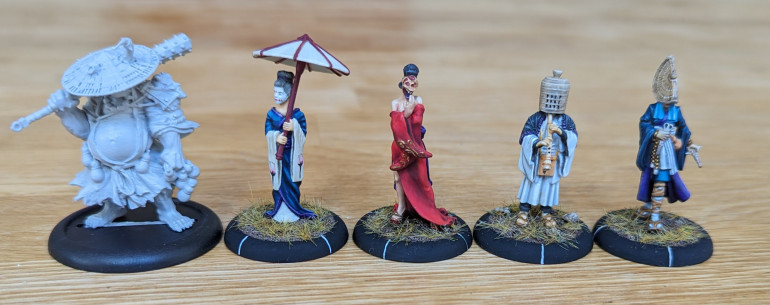 Team Photo (although the Kami was still in the changing room when this was taken). From l-r Eldest Brother, Ikiryo. Yama Uba, Mo Ises and Umeka
Team Photo (although the Kami was still in the changing room when this was taken). From l-r Eldest Brother, Ikiryo. Yama Uba, Mo Ises and UmekaTemple of RoKan forces
Followers of Inari Theme – Basically the Kitsune theme allowing all of the foxes. The theme provides an auto win on turn 9 (my son thinks this is great but I did point out that if the game is still going by turn 9, we’re doing something wrong!). It also allows a re-roll for all models on Ki and Size tests for one turn of the game. And when I use a Pass token, I must select one of his models that has taken wounds to heal 1 wound.
Kami of the Evening Flame. Kami are cheap and annoying. They aren’t really worth destroying as they take a bit of resource to do and they can’t really win scenario points. But, they either buff your own models or debuff the opposing models. In the case of this one, it can shoot small fireballs which cause a bit of damage and set the target alight (causing more damage). They can also ‘self destruct’ which removes them from the board but also causes an AoE
The White Faced Fox – Has a bow for long range damage and comes with a lot of skills that makes it hard to hit. Can shift into Fox form
Takeru – Has a Glaive which provides the very useful Combo Attack in melee. Also has bonus abilities against Soulless models (which is a lot of the Yurei list!) and can shift into a fox.
Kuoto – Provides some control/decision Ki feats that force the opponent to choose between certain events (most of which rob you of movement). Also has some handy combat abilities to deal out some melee damage. Can transform into a Fox for added movement.
The Nine Tailed Fox – Provides a dice re-roll buff to all friendly models and can reroll a lot of its own dice
Juko (with Prayer Beads) – Has a short ranged attack and a handy combo melee attack. Has skills that makes him hard to hit and can re-summon Kami that are destroyed. The Prayer Beads gives this model an extra 1 Ki each turn
Tengoko – Has a ranged attack and, if it hits, a damage dealing sword. Has some powerful debuff Ki feats
Test of the Fox Event. An opposing model must make a move challenge test. If they fail, they lose an activation (losing an activation is a big deal!)
Test of the Path Event. Opposing model must make a Melee challenge test and if they fail, they gain a control maker (effectively allowing the Temple of RoKan to control the model for one activation)
Test of the Man Event. Opposing model takes a size challenge test and if it fails it gains an impetuous marker (meaning that the model has to activate first which is a pain if there is a plan in place or the model was required to hold back later in the turn to provide it’s support)
Test of Inari Event. Opposing model take a Ki Challenge test and if it fails, it gains a Spirit Block Marker (this means that the model will not gain Ki in the following phase and Ki is used for special abilities, so this can really hamper the ‘big moves’ that can swing the game for you)
Gorinto – This is my son’s favourite terrain card and allows a friendly model to generate an extra Ki token if they are within range
Turn 1:
My son wins the Strategic test and takes the initiative. He doesn’t hand around with his Test of the Path and plays this straight away on Eldest Brother who fails his test and is controlled. My son wastes no time in getting Eldest Brother to attack his nearest model which is Umeka who is no match for an angry Oni and she takes 4 wounds. This was lucky as she just survived and it could have been a lot worse!
Most of my son’s models start in Fox form and move forward quickly. The White Faced Fox advances a long way, changes to Human form and fires its bow at Yama Uba, thankfully hitting but doing no damage. It does however put a Ki Block on Yama Uba, meaning she can’t generate Ki at the start of the next turn.
Takeru has advanced on my son’s left flank. He’s definitely looking to get round the side and into my back line where Ikyiro is. I’m having none of that and so Ikyiro takes aim with her Look into the Void Ki feat and hits, dealing 2 wounds.
Otherwise, the rest of the models spend the turn moving into position.
The pictures below are, my deployment, Temple of RoKan deployment, Eldest Brother smashing Umeka in the face, and two pictures of the state of play at the end of the turn.
Turn 2:
I win the strategic roll this turn and instantly activate Ikyiro. It’s a same as last turn Look into the Void blast on Takeru which succeeds and does enough damage to kill! Happy blasting from the little lady.
Kuto uses its Final Verdict ki feat on my kami, which fails its test and gains a death marker. This marker can be removed by spending ki (which the kami doesn’t have) and while the kami has a death marker, it makes them easier to hit in melee – so a big debuff. But I’m ok with this as the kami is somewhat expendable.
I advance Umeka into the the scoring zone on my left and my son uses the 9 tailed fox to attack Umeka. The 9 tailed fox gets to roll a lot of dice due to various buffs and debuffs and Umeka is not able to withstand the onslaught and is killed. This gives the 9 tailed fox control of the left hand scoring zone.
I move my kami and Eldest Brother into the central scoring zone, giving me control there.
Otherwise, there were some unsuccessful shooting attacks, Mo Ises tried to use his control Ki feat and failed and Juko failed to wound Mo Ises in melee. At the end of the 2nd turn, we both control a scoring zone each and therefore no VPs are awarded.
Turn 3:
My son plays Test of the Fox event (due to my Dharmic Path card, I’ve limited my son to playing his event’s in turns where there is no scoring so I don’t get a scenario point this turn). With this event, he nominates Ikiryo who fails her test and loses an Activation, which is a big deal.
Even with the loss of an activation, I feel Ikiryo is fairly safe at the back of the board and I spend her only activation to get blasting with her Look into the Void attack against Juko, who is also sneaking up on my right flank.Juko fails their test and gets a couple of points of damage for their trouble.
The White Tailed Fox charges Yama Uba but before combat starts, Yama Uba uses her Morph Ki feat to take Parry from WTF to aid her defence. Parry provides a straight up +1 to your defence, which is very handy. In the melee, my son puts a lot of dice into attack to compensate for Yama Uba’s newly found parry skill but he rolls very poorly and fails to get past her defence. Yama Uba only rolls one attack dice but rolls a six, easily beating WTF and rolls well on damage killing WTF outright.
It’s now just Yama Uba and the 9 Tailed Fox in the left scoring zone and I want to push the 9 TF out to get control, so I use Yama Uba’s second activation to enter melee. I hit but I’m not able to do any damage, so the scoring zone is still contested.
Juko is still in BtB with Mo Ises and continues to press the attack, Mo Ises isn’t great in combat and, despite rolling all defence dice, Juko is able to deliver 4 damage, almost killing Mo Ises.
I use Eldest Brother to attack Juko from behind and, with Mo Ises also in BtB, that’s two debuffs. Eldest Brother is able to use his Slam Attack special ability which delivers a wound and leaves Juko prone. This also removes Juko’s last activation and so Juko is now exhausted.
With Juko prone, exhausted and outnumbered (that’s -3 dice for Juko) I attack with Mo Ises. Despite being poor in combat, against a -3 dice debuff, Mo Ises is a lot better and rolls well. Well enough to kill Juko.
Tengoko, who has spent most of the game shooting and either missing or failing to damage moves into melee with my kami who is controlling the central scoring zone. Tengoko is able to hit but, due to the kami having Durable (which all kami do) the damage is limited to 1. Because I know that the kami can only take 1 damage and therefore not be killed this attack, I roll all of my dice into attack, giving me a massive success level, which, when I roll for damage, is a big number. Big enough to not even bother adding up as it kills Tengoko instantly.
Finally, Kuoto moves into the right hand scoring zone to control it and casts Final Verdict against Ikiryo but this fails this time.
Turn 4:
The 9 TF attacks Yama Uba twice and both times fails to do any damage, thanks mainly to Yama Uba’s Parry skill that she ‘borrowed’ from the White Tailed Fox.
Kyoto tries to use its Ki feat Dharma against Eldest Brother. If successful, the next time I Activate Eldest Brother, my son decides what action the model will take and I have to carry this out. I really want Eldest Brother to hand out some damage this turn, so I’m relieved when I pass the test.
Mo Ises moves into melee with the 9 TF from behind. This gives Mo Ises surprise and the 9TF is also exhausted and outnumbered as Yama Uba is still in BtB. This more than levels the playing field and Mo Ises is able to cause 6 wounds. Unfortunately, the 9TF has 9 wounds, so while a hefty amount of damage, it’s not enough. The 9TF is able to kill Mo Ises in return.
Ikiryo has been quiet and biding her time at the back of the board until now. With the middle scoring zone secure and the left one disputed by the 9TF, there’s really only one target for her Look into the Void Ki feat. The 9TF has a low defence against this attack, rolling 1 dice against Ikiryo’s 4, and Ikiryo is able to succeed and kills the 9TF.
This gives me control of two zones and, with my son only having Kuoto left, he decides he’s had enough and shakes hands.
Wrap Up.
Ikiryo is now my son’s most hated model. He thinks she’s grossly over powered and should be banned. She does deal some hefty damage but as I mentioned to him, she’s weak in combat and will take damage from shooting, so will go down quickly if targeted.
The Kitsune are also new models for my son and come with a very different play style to the monks he has been using. We chatted about possible synergies and how to adapt his play style. He also charged his models unsupported up the flanks which allowed me to pick them off.
From my side, obviously Ikiryo was a game changer, giving me some much needed range attack. And Eldest Brother added some real punch into the line which is something that the Cult of Yurei really lacks.
The Arms Race Begins - Ikiryo
I’m very behind on keeping this project up to date at the moment. But before Christmas, my son had purchased some reinforcements to his Temple of RoKan warband and these proved to be quite handy (see some previous battle reports). I also need some reinforcements so added some more models to my collection. First up to be painted is Ikiryo.
In game, Ikiryo is a glass cannon. She’s not cheap and gets to roll a single die in melee, so you really want to keep her out of BtB as, with only 4 wounds, she’s going to get minced pretty quickly. But you don’t take her for her combat abilities.
She does come with the Fear special rule with the highest challenge rating. To add to this, she also comes with Terror (anyone succeeding their Fear roll has to re-roll it) and Dread (anyone taking a Fear test does so with one less dice). So there’s a pretty good chance that anyone trying to enter BtB is going to end up with the Frightened state (which applies a bunch of de-buffs). So she has some defence if she does find herself in combat.
Her main abilities are the two Ki feats that she has. First up, is the Touch the Void ability. If she activates this before a damage roll is made, for each Ki point spent, 1 wound is cancelled. In addition, the attacker takes 1 wound. Handy.
Her other main ability is Look into the Void. For 3 Ki points, she can target anyone who has line of sight to her and within 8″. The target must take a Ki Challenge test against Ikiryo and if they fail, they take a damage roll. Basically, she has laser eyes to blast away at the enemy from behind the front line models.
The model itself is a simple two piece, with the parasol being a separate cast piece. This was easy enough to attach to the model but I did paint it up first. For the paint job, I wanted to aim for a Geisha look and aim for an ornate kimono. Basically, very different to the rest of my warband.
The kimono is a base of deep sea blue and I’ve shaded with a nightshade wash. I’ve then highlighted up using deep sea blue and increasing amounts of ice blue. The edging and belt (called an Obi I think) is purple with off white/purple mix for highlights.
I’ve opted for a pale skin with a light brown mixed in for shading. Once completed, I’ve painted over the face with a thin off white glaze before applying a red lipstick and makeup.
The parasol is a crimson red, highlighted with a mid red. Off white for the rest of the parasol.
I wanted some Japanese influenced design on the kimono. I would like to claim that my free handing skills are good enough to paint this on, but they aren’t. Kimono transfers aren’t really found in the wargaming world, so I turned to the world of nail transfers and, after a lot of searching, found some flower based transfers that looked close to a cherry blossom look. These were carefully applied to the sleeves and the rear of the kimono.
Basing was once again an acryllic dry earth given a brown wash. Then flocked with a dead grass.
Quick Fire Kami
My son wanted to use some Fire kami in his warband list and we didn’t have any models. This was easily rectified through the medium of Thingiverse and a 3d printer and the search term ‘fire elemental’. A quick resizing of the stl and 2 hours in the printer and we had a couple of fire kamis ready to paint.
In game, all kami (of which there are quite a few) are cheap and cannot interact with objectives. They also tend to be weak in a fight and low health. However, they all have the Durable special rule meaning they can only ever take a maximum of 1 damage per combat, so they take a little bit of effort to remove. They all have an annoying ability which either buffs your own troops, or debuffs the enemy. In the case of the fire kami, it can shoot small fire balls which causes damage and a flame attack. So in conclusion, they are annoying enough to want to kill but insignificant enough to really make you question whether you should be wasting your time on doing so. They really create a dilemma for the opposition.
Painting wise, this was a really basic and quick paint job. I watered down a yellow, orange and red and then based the entire model in yellow. While the paint was still wet, I’ve picked out the higher areas in orange and then red. This was all slopped on and I’ve allowed to the paint to mix on the model. Finally, once dry, I gave everything a yellow glaze (or two) to tie it all together. It all took a couple of hours.
Not perfect or going to win any awards, but quick and good enough for the table top.
Battle Report No.6
We played this game before Christmas but it has taken me this long to summon up the courage to tackle the project system to upload it! This was a quick game, so I’ll keep the report brief (at least for me!) but hopefully this will keep the usual suspects who like these battle reports happy.
Firstly, the mission. Having played a few games now, I definitely see that the game is designed for scenario play. Some factions and builds are not meant for a straight up fight and can win a scenario without killing a single enemy model. With this in mind, we opted for the simple 3 idol scenario with a game length of 6 turns. Scoring takes place at the end of turn 4, turn 5 and turn 6 with the side with the most scenario points gaining 1VP at the end of each of the listed turns. You gain one scenario point for each ‘friendly’ idol. Idols start the game neutral and can be turned friendly if a model in BtB spends an activation to interact with it. The idols are deployed along the centre line at 6” intervals.
My son opted for his Temple of RoKan and wanted to use his new models he picked up early December. His force was,
Master Po – This is a master monk who despite looking like a fat bloke who like a cuddle, is a combat monster. Hard to hit but he hits back twice as hard
The Grey Pilgrim – A ronin who is handy in combat but comes with a very useful lightening bolt ranged attack that can be buffed with Ki to make a second attack within 3” of the first target
Riku – a monk who has an affinity with water and includes a Tsunami Ki ability that effectively washes everyone backward across the board – useful for moving enemy models off of the objectives
Tsutsumi – a monk who has a sonic blast ranged attack that leaves targets prone (and therefore vulnerable to combat monks!)
He also took a Gorinto terrain piece to generate an extra Ki point per turn
I ditched my Cult of Yurei and opted for the Kiyozumi family that we got in the original start set that we picked up. Just for something a bit different. This allowed be to play the Kiyozumi Theme list giving me the bonus of turning one objective friendly from the start (I picked the middle objective) and during one turn, I get to win all tie breaks. Useful! In my list was,
Kiyozumi Kicho – Handy in combat and has some sneaky Ki feats
Kenmeina – an Ashigaru who can handle herself in combat and has some durability with her armour
Kiyozumi Sadaka – a Samurai and I’ve equipped with a card providing some defence against opposing Ki attacks
Kiyozumi Haiboku – a Samurai with a bow for handy long ranged attacks
Kiyozumi Hinadori – a healer who I’ve also given a golden sword in case she gets into combat
Turn 1
I moved my models up behind the fence to get a bit of protection and use some of my ranged attacks to soften the enemy up. My son was aggressive and ran forward to the idols, really wanting to get into position to get into combat. I was able to get Sadaka to use her ranged Ki ability to drain the Grey Pilgrim of some Ki which will limit here ability to launch lightening bolts
Turn 2
My son kicked off turn two by activating the Grey Pilgrim. The pilgrim used her Ki feat of Rajins Rage which allows any successful lightening bolt hit to leap to any model within 3” for a second attack. She proceeded to zap Kicho for a point of damage and then managed another point against Sadaka. I got off lightly on that attack as it could have been a lot worse!
Haiboku used his Dai Kyu long bow against the Grey Pilgrim as retribution for her lightening attack. This went very well, and he was able to skewer her for 4 points of damage. I was feeling pleased with this….
Riku, the water monk, charged into Kenmeira. During the rolling of the melee dice pool, I managed to roll all 1s. My son, who has an uncanny ability to roll good dice, rolled very highly resulting in a massive success level in attack. He managed 8 damage, which is a huge amount in one turn, especially given that Kenmeira has armour that reduces the damage roll. Kenmeira is not able to withstand such an attack, and dies.
Master Po then gets in on the action and attacks Sadaka. Fortunately, Haiboku is close by and activates his Bodyguard ability, switching places with Sadaka. Having fought Po before and knowing how good he is in combat, I went full defensive and used Haiboku’s push defence ability. This works, as Po’s attacks fail to get through and Haiboku can then push Po back 1” out of BtB and combat. A lucky escape!
Looking to overload Po, I get Kicho to attack him and she is able to land 1 damage, but this is annoyingly cancelled by Po’s tough ability, so the combat ends without damage.
My son, looking to take out Kicho, uses The Grey Pilgrim’s Lightening Bolt attack against Kicho. But, as she is in BtB with Po, he has to roll off to see if he hits Po. Amusingly for me, he does, and Po gets zapped for 1 damage. I laughed, my son didn’t.
With Po exhausted (out of activations), I got Kicho to press the attack. Being exhausted automatically removes a dice from your melee pool, so this makes an attack on the mighty Po slightly easier. You allocate your melee dice pool secretly and also select any available special attacks/defences secretly as well. My son put all of his dice into defence and opted for the Counter Strike Defence special defence. In this case, if Po’s defence dice pool beats Kicho’s attack pool by 2 or greater, then Po gets to make a damage roll. And this is exactly what happens and Kicho takes a point of damage.
Turn 3
My son gets the initiative and wastes no time in activating Po who is still locked in combat against Kicho. Kicho is grossly out matched and despite me putting all of my dice into defence, Po used his Crushing Wave Strike Ki feat (which means I must remove my highest defence dice), it wasn’t enough. Po was able to deliver a blow that killed Kicho.
With two models removed from my faction and I’m nowhere near any of the objectives, I’m in deep trouble. I try to strike back with Haiboku’s long bow but manage to miss everything. Riku then uses his tsunami Ki feat, which requires all enemy models to take tests to avoid being pushed backward 8” (or up against any immovable terrain). I fail most of the tests and my warband is now scattered and further away from the objectives.
The Grey Pilgrim is now able to get into combat with Sadaka and does so. Sadaka does her best but takes 2 wounds. My attacks are just not getting through and causing damage.
Po continues his rampage and moves into combat with Haiboku. Haiboku rolls a lot of defence dice but is not enough to avoid taking another point of damage.
Finally Tsutsumi gets into the action and attacks Hinadori in the rear which gives him a lot of bonus dice to his attack. It’s too much for Hinadori who takes a massive 8 damage, which would be enough to kill off most of the models in the game and Hinadori is no exception.
Turn 4
This is a scoring turn (at the end) and despite losing over half of my warband, I’m actually still in the lead! But in reality, it is all over quickly as the Grey Pilgrim quickly despatches Sadaka and Po takes out Haiboku. Overall, it’s a very one sided game and my warband is completely crushed.
Conclusion
My son was very aggressive and Master Po is certainly worth his points value, providing a lot of consistent melee output. I was overwhelmed from the start and never got into the fight.
Interestingly, had we been playing a tournament game, tabling your opponent doesn’t automatically give you a win. The game automatically stops when an opponent is completely defeated and as this happened in during turn 4, there was never a scoring event and the game would therefore have finished in a draw. Had I survived to the 5th turn and still had the one objective scoring for me, I would have taken a victory point at the end of the 4th turn and then won the game. There will be many out there that would disagree with this, as tabling your opponent surely means that you win, but this does create an interesting dynamic to the game. Even in list building, you need to think about which of your models will handle the scenario objectives and which will be providing another role.































![How To Paint Moonstone’s Nanny | Goblin King Games [7 Days Early Access]](https://images.beastsofwar.com/2024/12/3CU-Gobin-King-Games-Moonstone-Shades-Nanny-coverimage-225-127.jpg)
